Introduction
Everyone collecting Pokémon Cards for years and being active on forums may have seen them: threads with lists of Base Pikachu Card variations. If you google for it you’ll come across quite a few posts from around 2005-2010. Most mention about ten or maybe fifteen unique Base Pikachu Cards. I think almost everyone has heard about the Red Cheeks Pikachu, the Ghost/Phantom 1st edition misprint, or the ‘4th’ UK print.
Well, in this article I will go over every Base Pikachu Card variant that exists, and let me tell you, there are quite a few more than fifteen. In fact, as of right now I own 59 81 different variations myself, and there are a couple more hard-to-find variations I know to exist (which I will hopefully add to my collection in the not too distant future).
DISCLAIMER: The cards aren’t shown in chronicle order. This article is only to show all variants and how to distinguish their differences.
Base Set
English
Regular English (US) unlimited edition Base Set
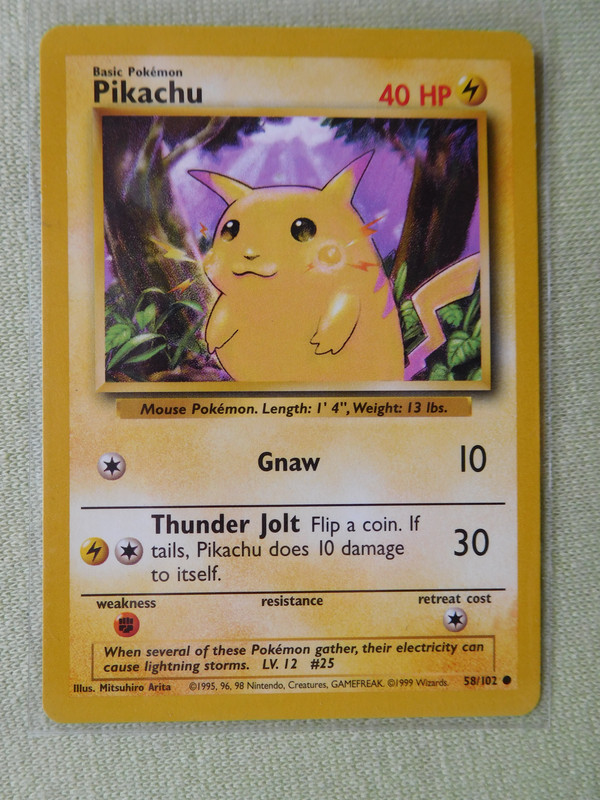
This is a plain old unlimited edition English Base Pikachu. Probably everyone that has been collecting Pokémon Cards since close to the beginning will have this card in their collection.
So what defined this ‘regular’ Base Pikachu, which will be used as a template for this article?
- First of all, the card is written in English.
- The artwork will have yellow cheeks (indicated with grey in the picture below)
- There is no first edition symbol at the left side of the card (indicated with green in the picture below).
- Since it’s the Base Set, it won’t have any set symbol at the right side of the card (indicated with blue in the picture below).
- It will have shadows around its artwork (indicated with purple in the picture below).
- And finally, it will have a copyright date of ©1999 at the bottom right (indicated with red in the picture below).
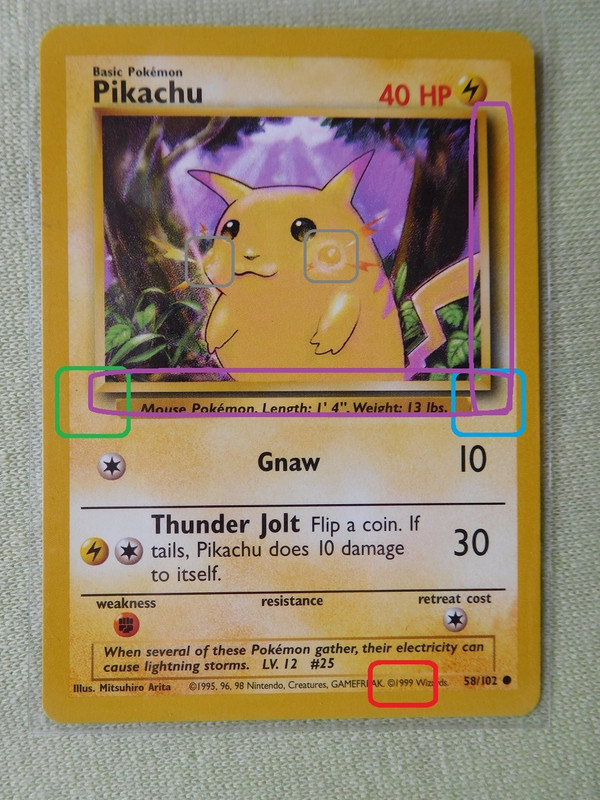
Now that we know where to look for, let’s go over all the other cards.
English Shadowless 1st edition (2D) Red Cheeks
SPOILER: Click to show
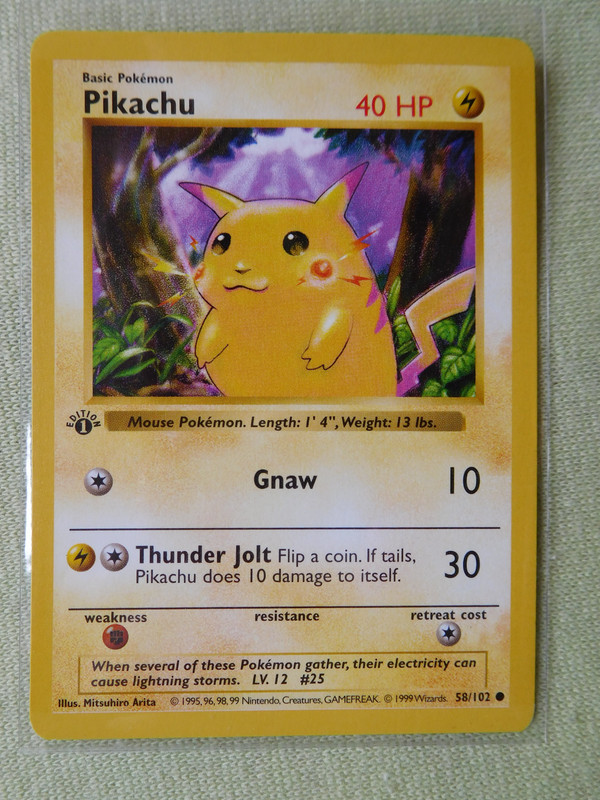
Compared to the first card shown, we’ll see three major differences:* The 1st Edition symbol
- The shadowless borders around its artwork
- The red cheeks in the artwork
Some other minor differences include:
- The thinner font (especially noticeable at the “40 HP”)
- These Shadowless cards usually have a lighter overall color
- The “Thunder Jolt” attack is just two lines on the Shadowless Pikachu cards, but three on the unlimited edition Pikachu cards
- The first part of the copyright date of Shadowless cards mentions “© 1995, 96, 98, 99”, which will be “©1995, 96, 98” on the unlimited edition cards
When the first few cards of the Base Set were printed they still had Shadowless borders, unlike all the other WotC sets, or the later releases of the Base Set. In addition, the Base Set Pikachu was first printed with Red Cheeks, but WotC later switched to Yellow Cheeks instead. This change is by a lot of people mentioned as a misprint, and therefore this Red Cheeks Base Set Pikachu is considered to be the most well-known and easy to find misprint in the Pokémon TCG. Officially however, it isn’t a misprint. Although Mitsuhiro Arita’s original artwork (as can be seen on the earlier Japanese print) was with Yellow Cheeks due to the lightning bolts in the artwork, WotC employees thought the cheeks were supposed to be red since it’s Pikachu, so they changed it without Mitsuhiro Arita’s permission. They later on corrected it back to yellow cheeks. (Source: From a friend who got in contact with Mitsuhiro Arita himself in person at events, as well as on Facebook.) Neither of them are misprints, but the Red Cheeks aren’t Mitsuhiro Arita’s original artwork.
English Shadowless non-1st edition Red Cheeks
SPOILER: Click to show
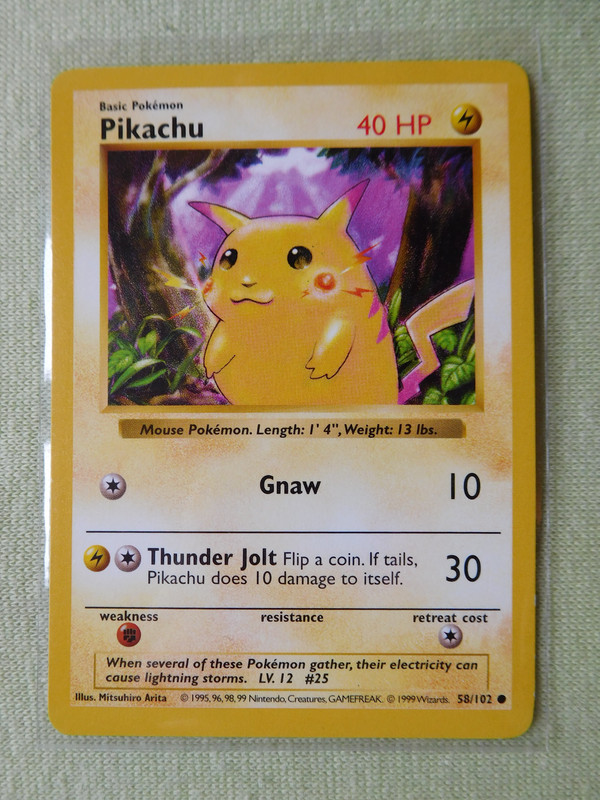
Same as the previous, except this one is lacking the 1st edition symbol. Usually we call the lack of 1st edition symbol an unlimited edition print, but let’s call this non-1st edition instead, due to the fact the Shadowless cards only had one print run, instead of an ‘unlimited’ amount.
English Shadowless 1st edition 3D Yellow Cheeks
SPOILER: Click to show
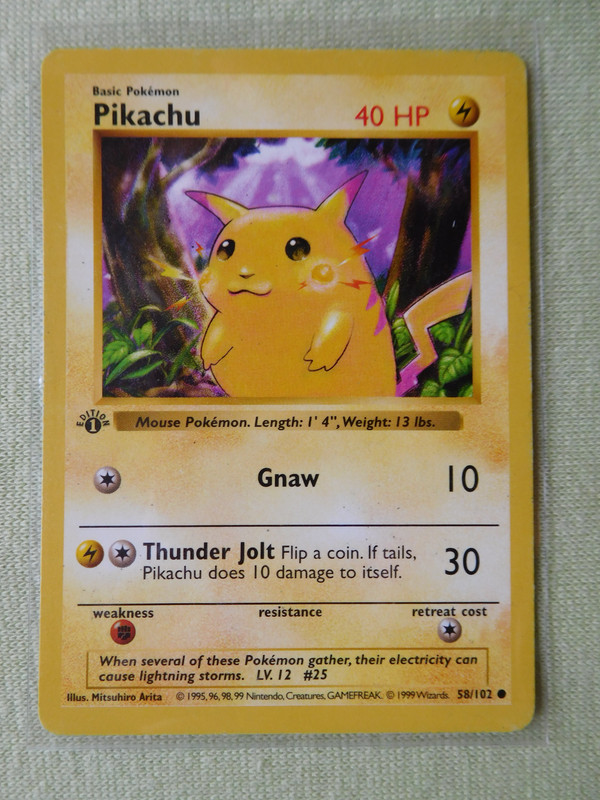
This one is similar to the English Shadowless 1st edition Red Cheeks, except with the intended Yellow Cheeks instead of the misprinted Red Cheeks.
English Shadowless non-1st edition
SPOILER: Click to show
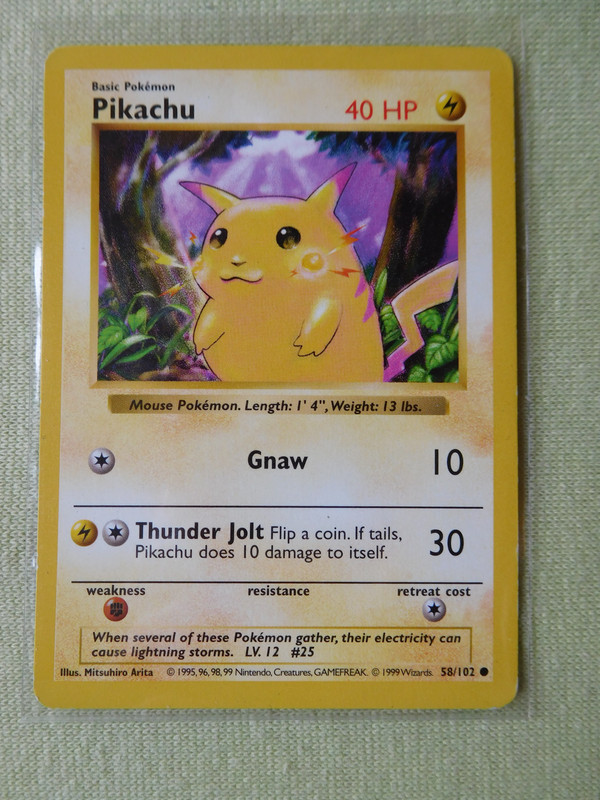
The same as the regular English Base Pikachu we’ve indicated as ‘template’, except for the Shadowless borders instead of borders with shadows around its artwork.
English Shadowless non-1st edition Yellow Cheeks from the Japanese CD Promo set
SPOILER: Click to show
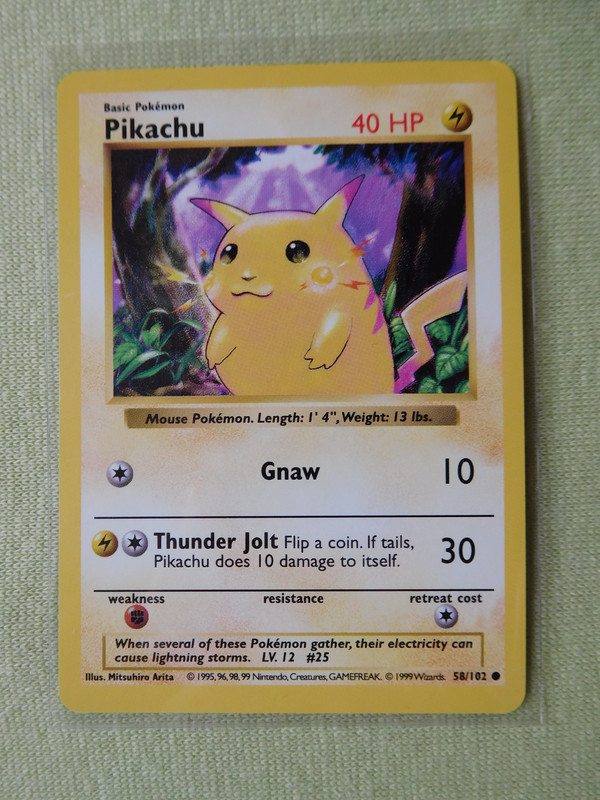
As you may have noted, this one looks exactly the same as the previous card mentioned. In fact, these two cards are very hard to distinguish from one another.
This English card was released in a Japanese CD Promo set along with some other Japanese Cards. Because of that, it was printed on Japanese Pokémon Card paper/cardboard, which is ever so slightly thinner than the paper/cardboard used for English cards. If you shine through both of them with a flashlight, the Japanese CD Promo will let more light come through than the English printed one. In addition, the Japanese CD Promo is overall lighter in color.
The best way to ensure you bought the Japanese CD Promo card however, is to get it in it’s original seal. But in doubt the ‘flashlight test’ is a pretty good indication of which is which (if you have both of them to compare).
English (Australian) PokéTour1999 stamped
SPOILER: Click to show
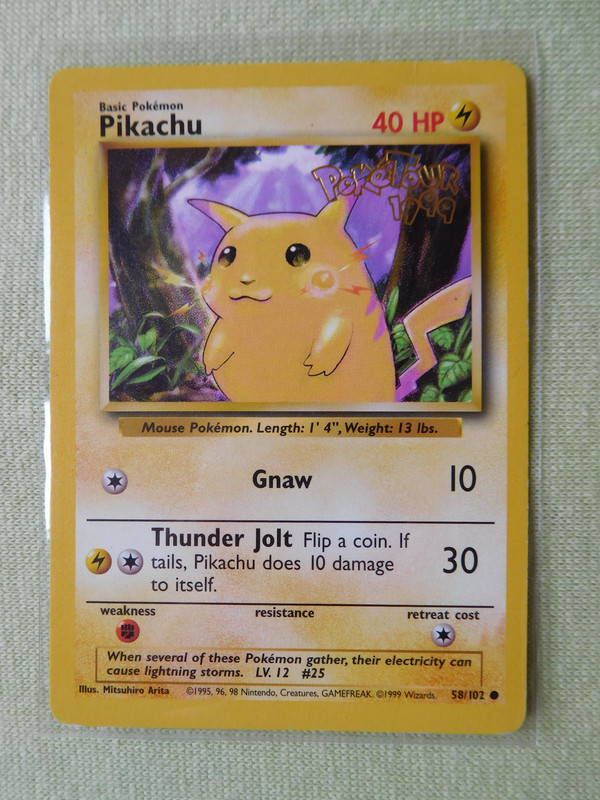
This card is the same as the regular English Pikachu, but has a PokéTour 1999 stamp in the top right corner of it’s artwork. These cards were included in ‘Tour Packs’ distributed at locations visited by the PokéTour members in Australia in September and October of 1999.
English Red Cheeks E3 stamped
SPOILER: Click to show
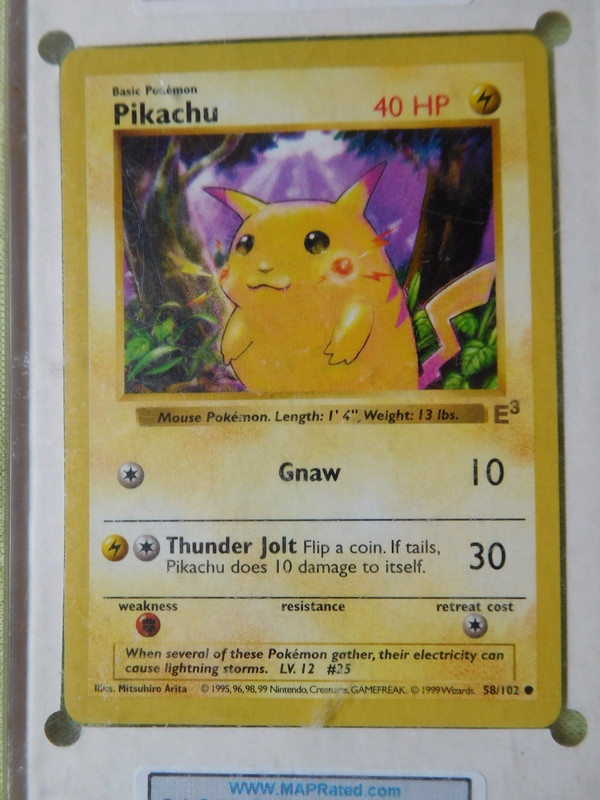
(Excuse the bad quality MAP-grading case it is in…)
The E3 Pikachu cards were given away at the E3 (Electronic Entertainment Expo) events in Los Angeles on May 1999. This card is considered to be the first American promo card. This is the rare Red Cheeks variant, of which the productions were quickly stopped to replace it with the Yellow Cheeks variant (shown below). Current prices (at time of writing) of the Red Cheeks and Yellow Cheeks E3 cards are approximately 190-260 and 5-10 USD respectively.
English Yellow Cheeks E3 stamped
SPOILER: Click to show
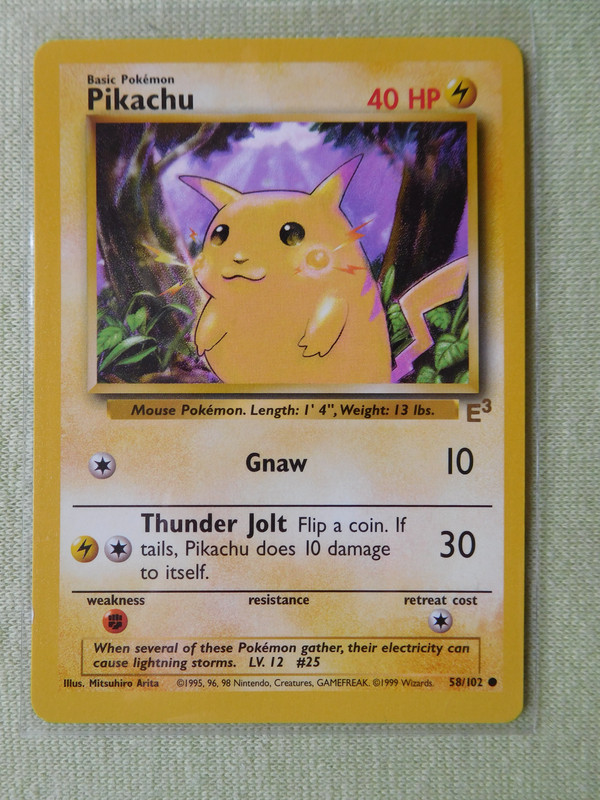
English Ghost/Phantom “E ITION” 1st edition misprint
SPOILER: Click to show
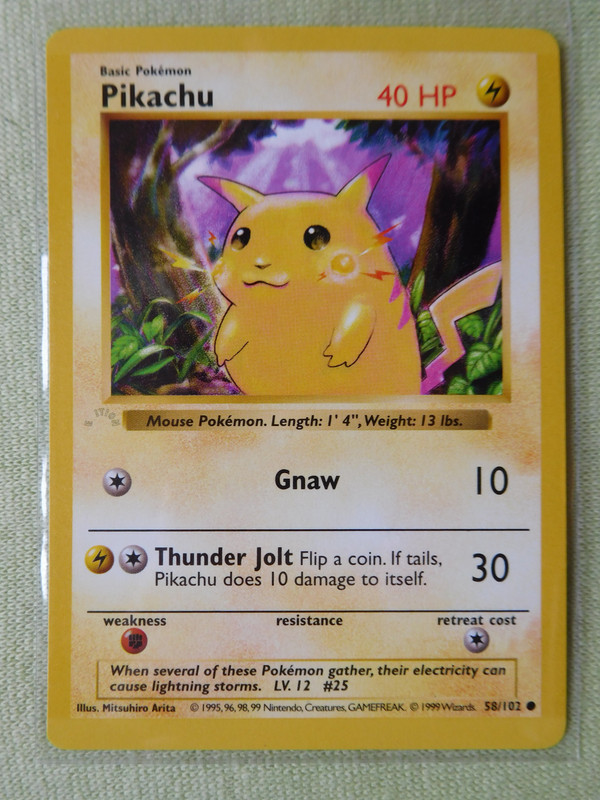
In this misprint, the 1st edition letters are only partially printed, leaving out the “1st” part, and the “D” in “EDITION”. Also, unlike the regular black 1st edition symbol, the letters are hollow and only have the outline printed. Despite being a pretty strange misprint with these charismatics mentioned above, the Ghost/Phantom 1st edition misprint isn’t a one-of-a-kind occurrence and is actually pretty well-known.
Although it was never confirmed, these “E ITION” markings of the Base Ghost/Phantom Pikachu might have been added during the printing process as indication, so the 1st edition stamps would be properly aligned (which kinda failed in most cases). These Ghost/Phantom Pikachus slipped through the process as misprints.
With some of the 1st edition Base Set cards you’ll notice the 1st edition stamps will look almost 3D (except for the “1st” and “D”), due to misaligned 1st edition stamps. All 1st edition Red Cheeks Pikachus are probably aligned/2D, and almost all 1st edition Yellow Cheeks Pikachus are misaligned/3D. Here is a zoomed in picture of one of my 1st edition Yellow Cheeks Pikachus 1st edition stamp:
SPOILER: Click to show
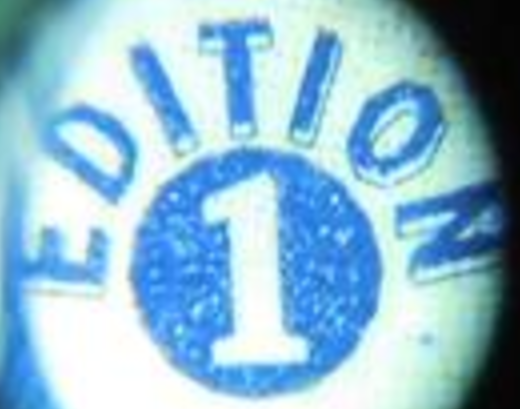
These Ghost stamped Pikachus could be found in ZAP! Shadowless Decks with a gold strip around them, which can be seen in the opening of such a Deck in this YouTube video.
English Shadowless 1st edition 2D Yellow Cheeks
SPOILER: Click to show
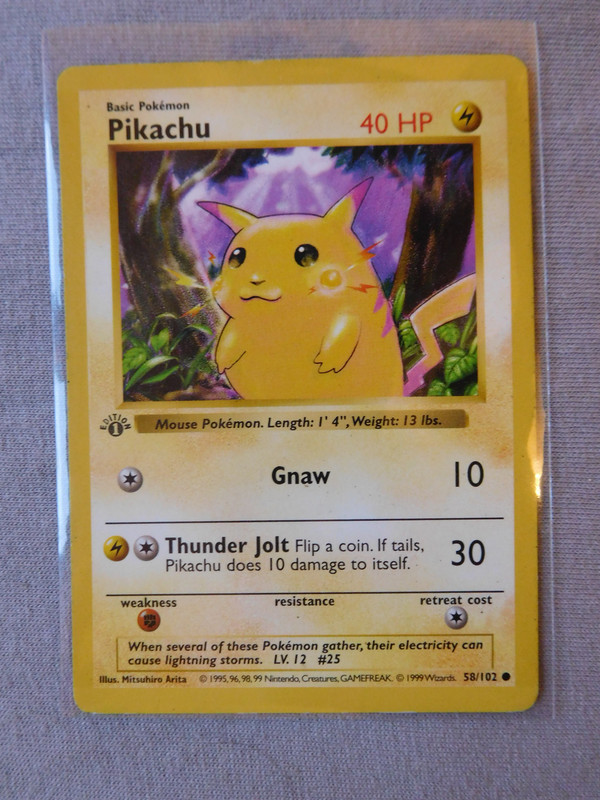
As I mentioned above at the Ghost stamp Pikachu, all Red Cheeks have 2D stamps (as far as I know), and almost all Yellow Cheeks have 3D stamps. This one above however, is a Yellow Cheeks with 2D stamp. Here is it’s 1st edition stamp zoomed in:
SPOILER: Click to show
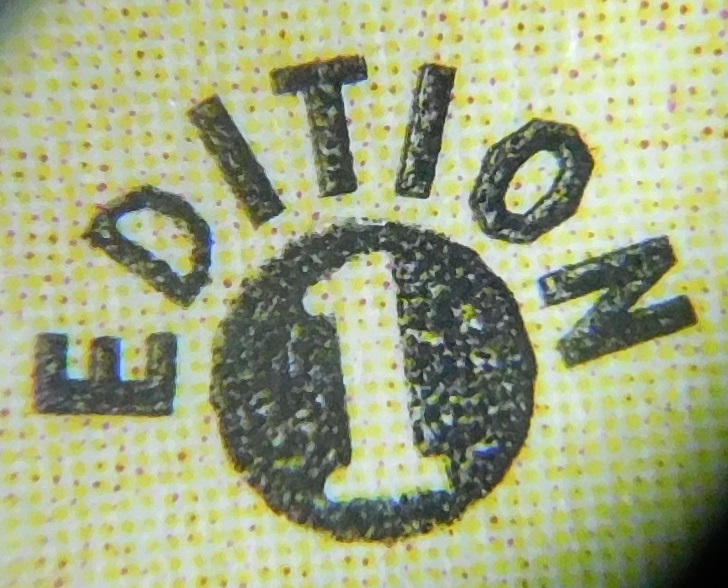
English (UK) ‘4th’ print run ©1999-2000
SPOILER: Click to show
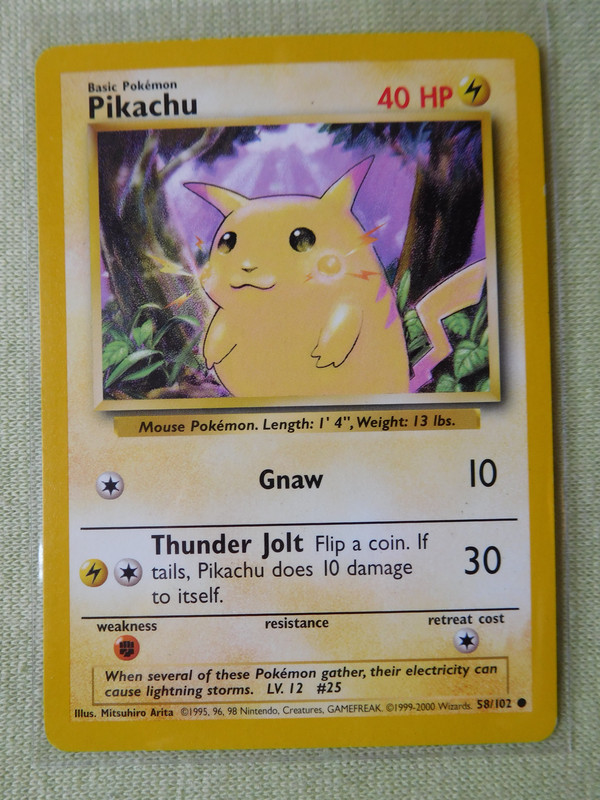
There were multiple print runs for the Base Set, 8 to be exact. The 1st print run were the Shadowless thick stamped 1st edition cards. The second print run were the Shadowless thin stamped 1st edition cards (mainly consisting of Base Set holos). Then came the non-1st Shadowless cards. Then they’ve added the shadows and made some other small changes, so the fourth, fifth, sixth, and seventh print runs were unlimited edition, and these four print runs don’t have any differences as far as anyone could tell (I have heard some rumors about some semi-glossy unlimited edition Base Set cards however, which I’m still investigating - although those seem to be regional differences instead of print run differences). The 8th and final Base Set print run however, which was printed and released for the United Kingdom, has a small difference with the regular English Base Pikachu. As mentioned before, that ‘template’ Pikachu card had a copyright date of ©1999. Well, this 8th UK print run of the Base Set has a copyright date of ©1999-2000, and is harder to find due to many average collectors not knowing they have a different card in their possession than just the regular US version.
(It is also better known as the ‘4th’ print run, due to people merging together some print runs into the following four: 1st edition Shadowless; non-1st edition Shadowless; unlimited edition ©1999; unlimited edition ©1999-2000.)
source
English Grey 1st edition stamp Yellow Cheeks
SPOILER: Click to show
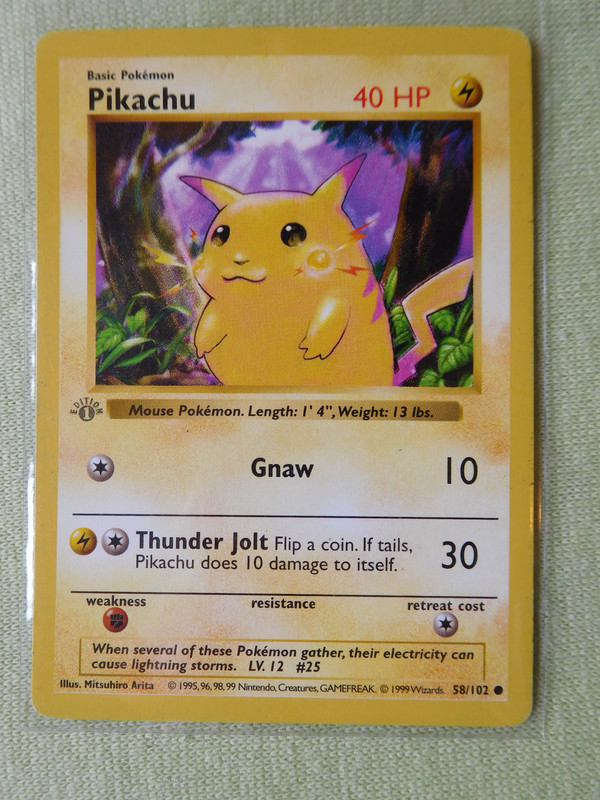
If we look at the 1st edition symbol of the card above we can see it’s grey instead of black. For the 1st edition Base Set cards in general there are three different versions of the 1st edition symbol:
- the regular (Thick black) one;
- this grey one;
- and one that people call ‘Thin print’.
These three different versions are only caused by how firmly the printer pushed down when printing the 1st edition symbols. Did it not push hard enough, then they were usually Grey stamps like the one above. Did they push too hard (which became a standard in later sets), then they were ‘Thin prints’ (these ‘Thin prints’ will be mentioned later in this article).
EDIT: A new and more likely theory has presented itself for Grey stamps in this post by @pokemonrevolution . Sometimes we come across 1st edition Base Set cards with imprints of the 1st edition stamp at the back of their card (see below). The new theory presented by @pokemonrevolution suggests sheets are stacked on top of each other before the 1st edition stamp ink was dry, causing both the imprints at the back of the cards, as well as the Grey stamps.
English Shadowless 1st edition Red Cheeks with 1st edition Black stamp imprint on the back
SPOILER: Click to show
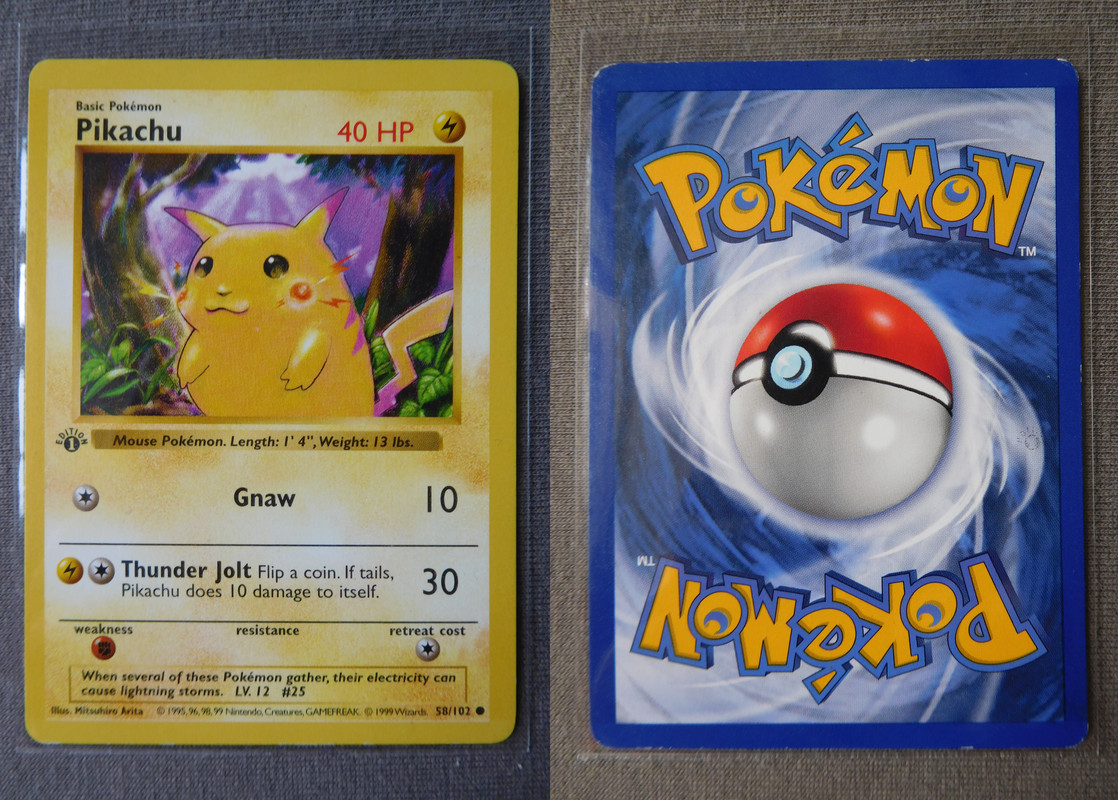
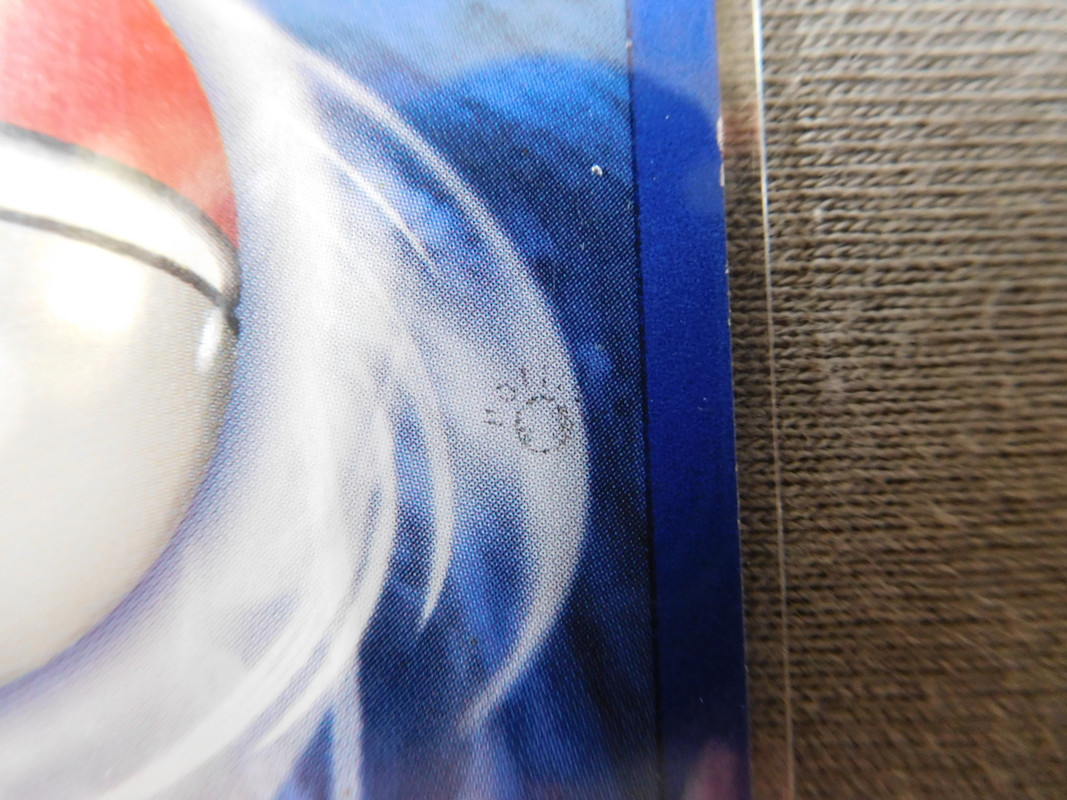
With some 1st edition Base Set cards you’ll find these 1st edition stamp imprints on the back. Usually they are very vague and almost unnoticeable, and sometimes it’s a bit easier to spot like the one pictured above (although still pretty vague).
I have yet to see a Yellow Cheeks Base Set Pikachu with a stamp imprint on the back, but I currently have two Red Cheeks Base Pikachus with stamp imprints on the back in my possession.
English Shadowless 1st edition Red Cheeks with 1st edition White stamp imprint on the back
SPOILER: Click to show
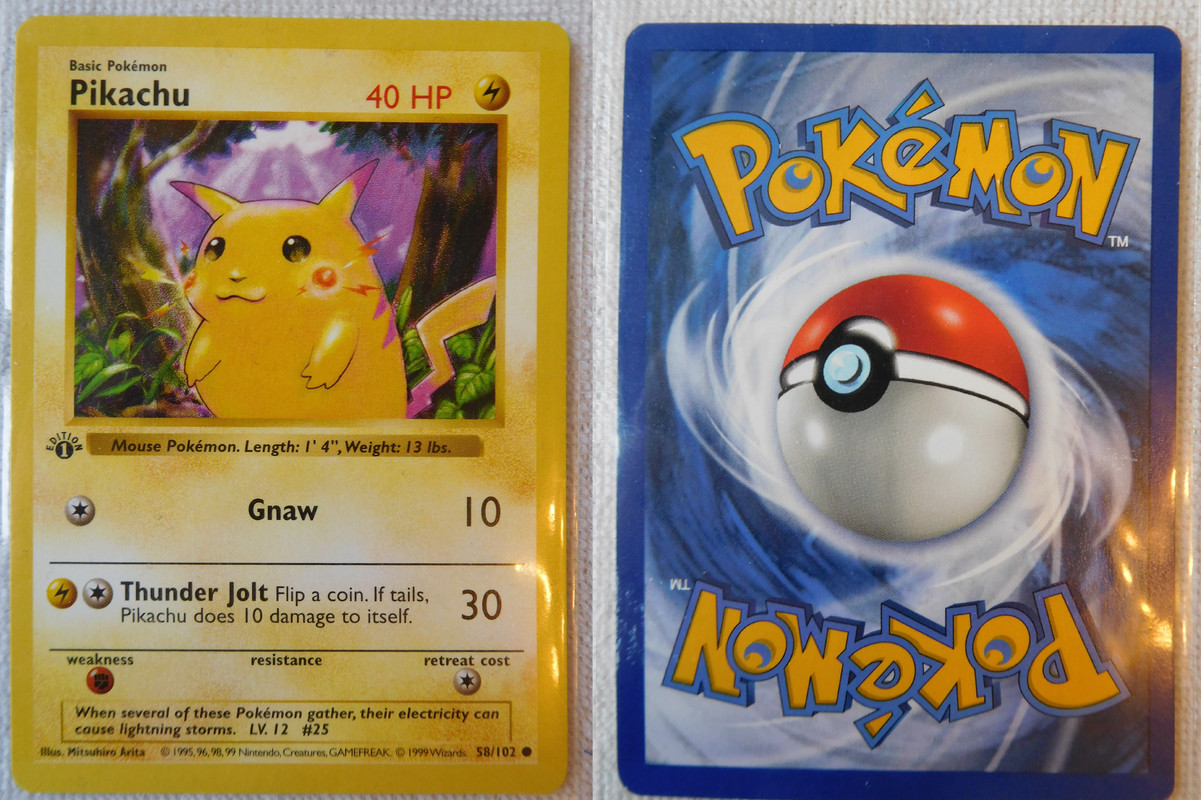
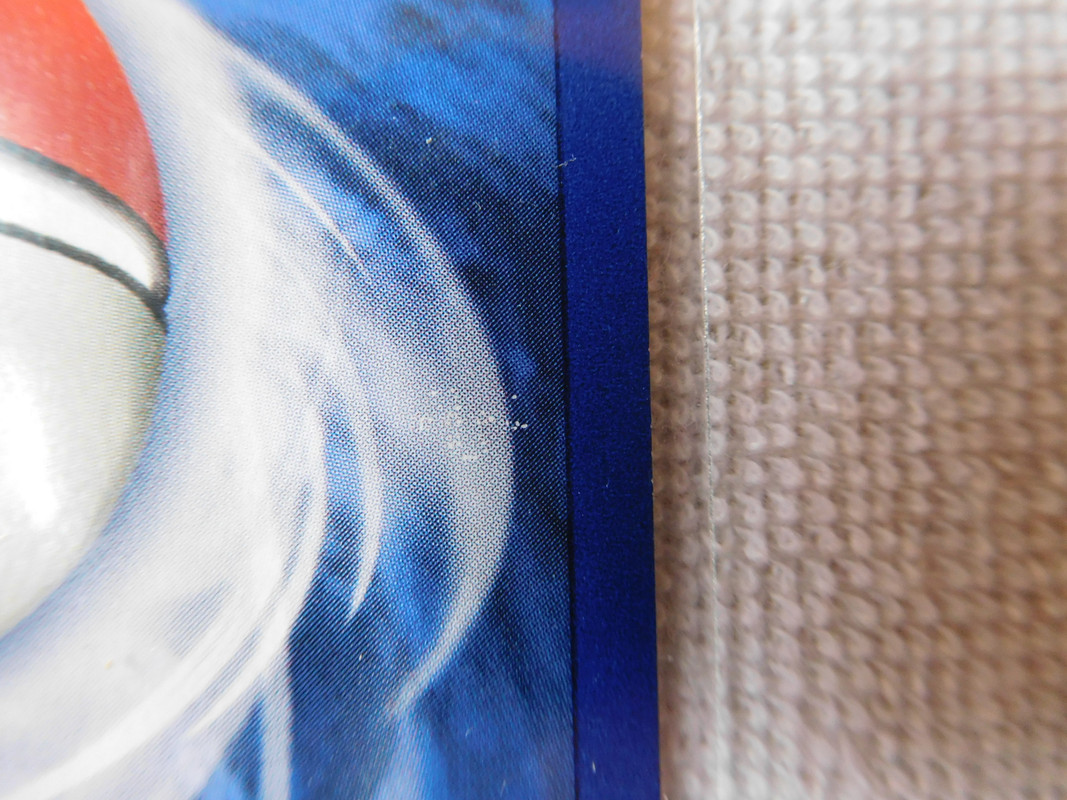
It’s also possible that a white imprint of the 1st edition stamp is left behind on the back, instead of black. I’m not entirely sure how this happens, though. At first I thought this happens when the ink acts like some kind of glue, basically ripping the printing of the white paper. However, when I look at the Pikachu I have in my possession above, no such damage can be spotted whatsoever. So how the white stamps happen I don’t know, but they are out there just like the result black back imprinted stamps.
Regular English (US) unlimited edition Base Set with Strikethrough Copyright Information
SPOILER: Click to show


There is an error for the English ©1999 unlimited edition Base Set Pikachu where there is a black line through the copyright information, as can be seen in the picture above. I’ve seen three cards with this misprint so far, so it’s not a one-time occurrence. All three of these can be found in this video of @TCAGaming , who was so kind to send one over to me for my collection. ![]()
Regular English (US) unlimited edition Base Set (three variations): Semi-Glossy vs Matte vs Matte with Semi-Glossy Borders
SPOILER: Click to show

Source: Image from @scratchdesk 's “Pokemon Base Set Variants - Matte and Glossy finish” thread. (I do have all three variations, but Nate managed to capture them on camera a lot better than I would be able to.)
Coming back to the regular English unlimited edition Base Set Pikachu we have as template: there are three distinct versions of this particular card. It’s not sure yet whether these are print run differences, or factory differences (perhaps even from different countries), but there seems to be three versions available for each of the Base Set Commons, Uncommons, and Energies:
- Semi-Glossy
- Matte
- Matte with Semi-Glossy Borders
When you look at the image above: the top card is the third variations; the second is Matte; and the third and fourth are both Semi-Glossy. These aren’t as glossy as Japanese Glossy Promos by far, but they are best comparable to the backs of the Australian Red Logo Jungle Set cards. The backs of the Jungle Set cards that come from Red Logo packs (which were produced and distributed in Australia) are semi-glossy as well. Here is a picture I took of a regular and Australian Jungle Pikachu from my collection. You can clearly see the LED-lights of my flashlight on the Australian one - an indication they are more reflective, while it’s just a light-blur on the regular one.
The Semi-Glossy Pikachus aren’t as easy to spot as the backs of the Australian Jungle Set cards, but when you have all three cards next to each other like in the image above, you can clearly see the differences.
English Base Set 2
SPOILER: Click to show

Base Set 2 is a combination of some Base Set and Jungle cards. Wizards of the Coast (WotC) usually releases sets with reprints from previous sets for their card games, and the Pokémon TCG was no exception. This turned out to be a pretty unpopular set however, so therefore it was never released in Japan.
It has the Base Set 2 symbol at the right side of the card (and it also has the ©1999-2000 copyright date, since it was released in February 2000).
Japanese
Japanese Bulbasaur Intro Pack
SPOILER: Click to show
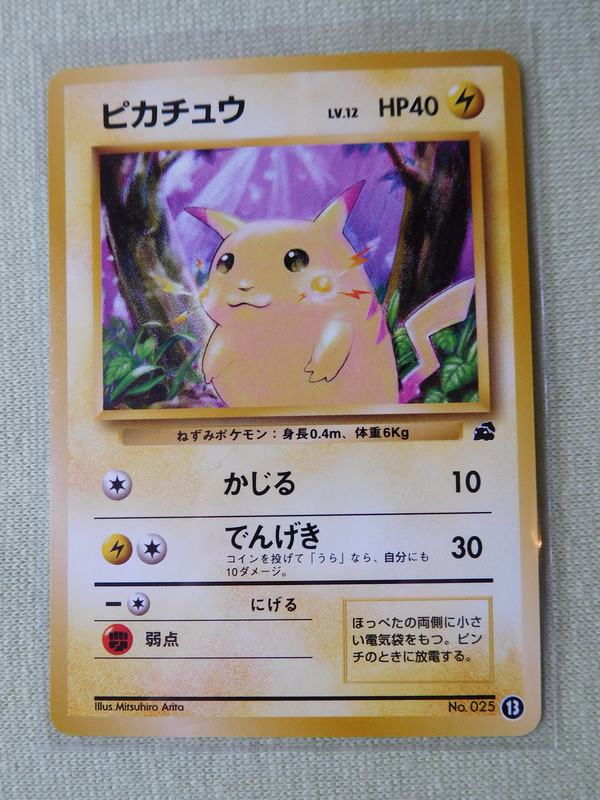
The Japanese Intro Pack was, as it name implies, an introduction for new players to the TCG. These Intro Packs were broken into two different decks: a Fushigidane (Bulbasaur) Deck and Zenigame (Squirtle) Deck. This card pictured above is the 13th card in the Bulbasaur Intro Pack, and has a Bulbasaur set symbol at the right side.
Japanese Totodile Intro Pack
SPOILER: Click to show
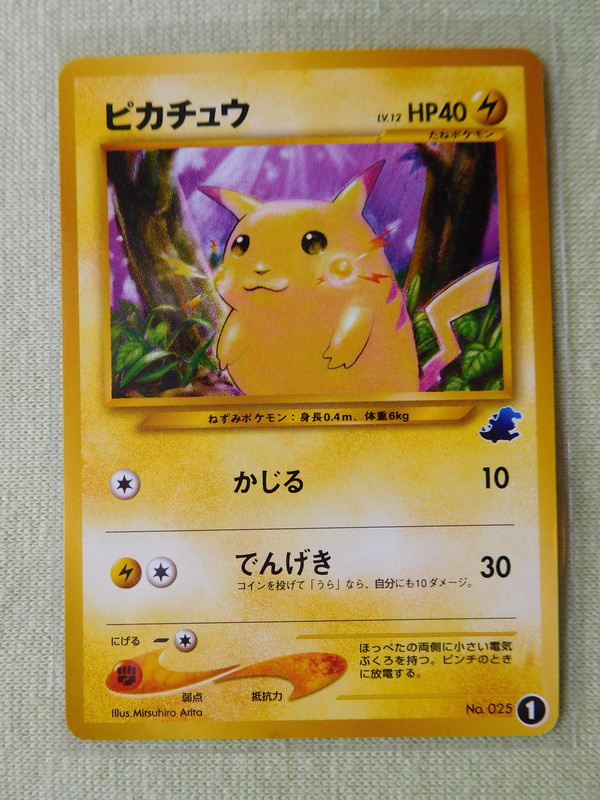
This was an Intro Pack similar to the Bulbasaur Intro Pack mentioned above. This card is the 1st from the Totodile Deck for one of the Japanese Neo Packs of 2001. Just like the Bulbasaur Intro Pack Pikachu mentioned above, it has a Totodile set symbol. There are also a few small differences in layout and color for these two cards, due to this card being from a newer release, where the Japanese cards had a different style.
Japanese No Rarity Expansion Pack
SPOILER: Click to show
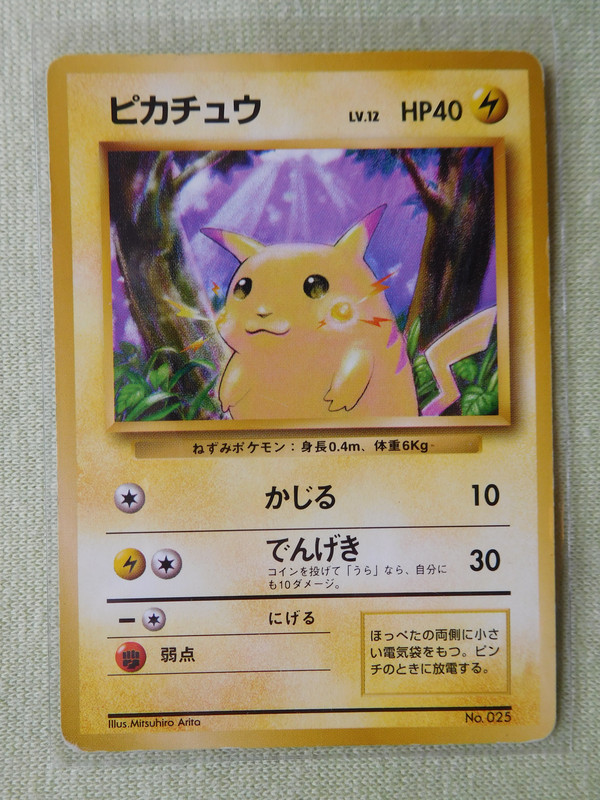
This Japanese Set is the origin of the Pokémon TCG and was released on October 20th, 1996; today (October 22nd, 2016) almost exactly 20 years ago. The name “Base Set” was given to this set by fans and collectors because it was the basis for the Pokémon TCG, but initially it was simply released as “Pokémon Card Game”. This Japanese set is nowadays mostly known as “1st Starter Pack”.
These No Rarity Base Set cards were the 1st edition cards of this Japanese set, and the only WotC set released without rarity symbols (excluding some Decks).
Japanese Expansion Pack
SPOILER: Click to show
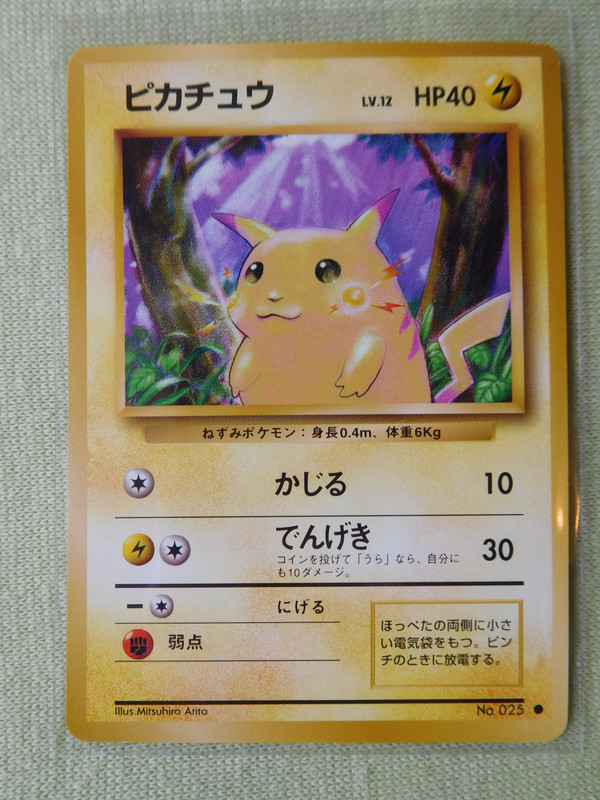
Compared to the previous Japanese No Rarity card, this is the unlimited run of the Japanese Base Set and has the round Common rarity symbol in the bottom right corner. This Japanese set is nowadays mostly known as “Expansion Pack”.
Dutch
Dutch 1st edition
SPOILER: Click to show
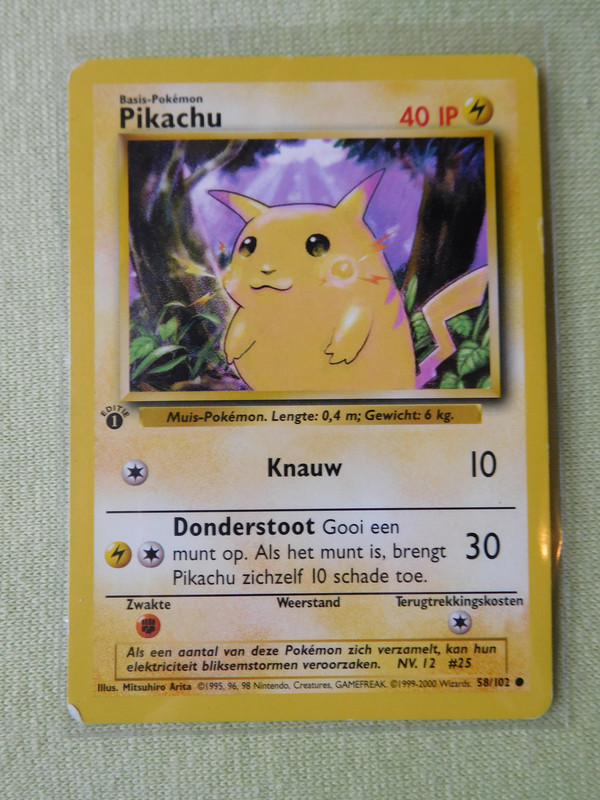
Now we are getting into all the different languages that were released for the Base Set, both in 1st edition and unlimited edition print runs. This first one is the Dutch 1st edition.
Dutch unlimited edition
SPOILER: Click to show
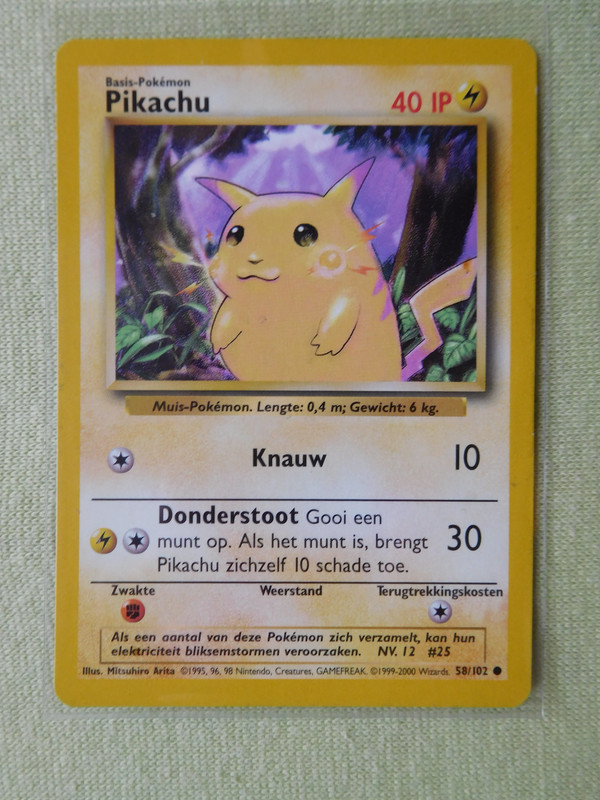
German
German 1st edition
SPOILER: Click to show
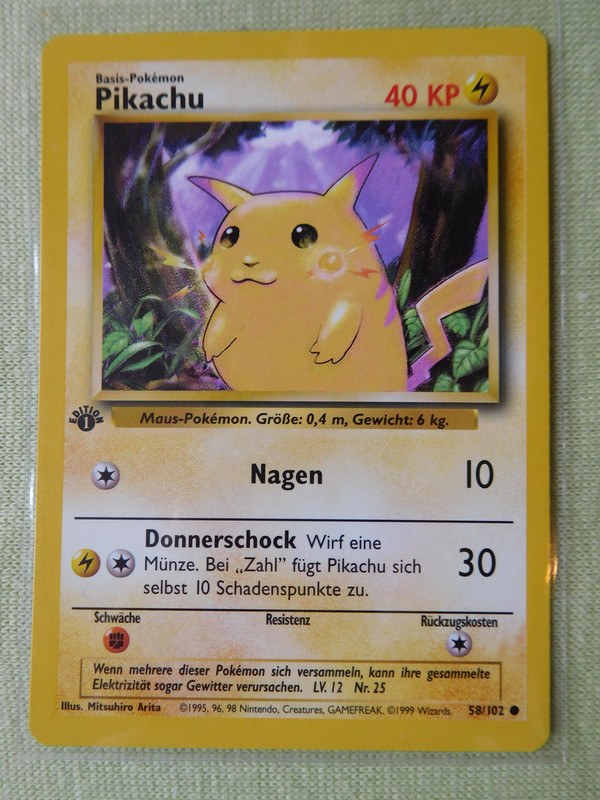
German unlimited edition
SPOILER: Click to show
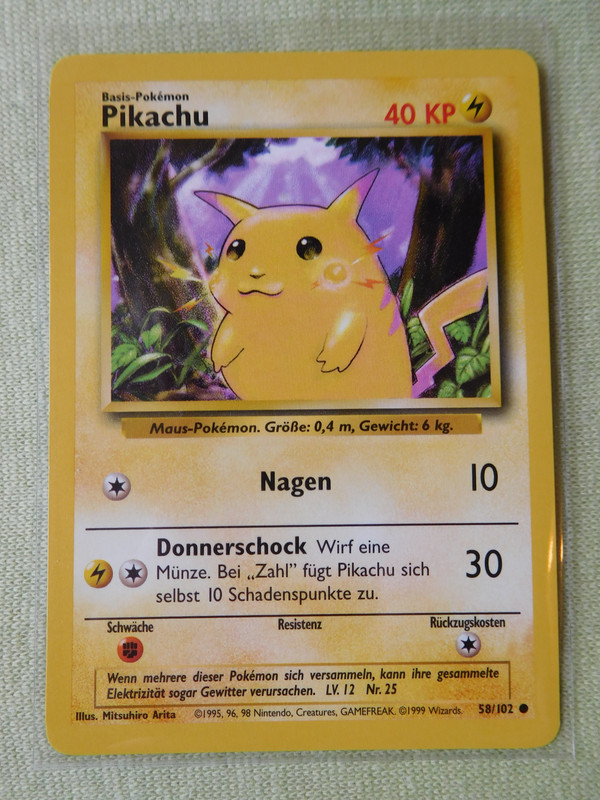
French
French 1st edition
SPOILER: Click to show
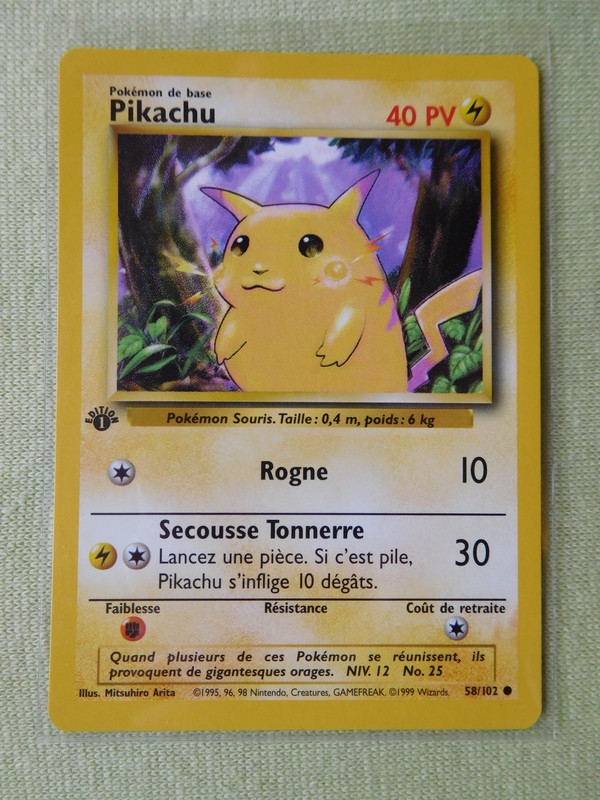
French unlimited edition
SPOILER: Click to show
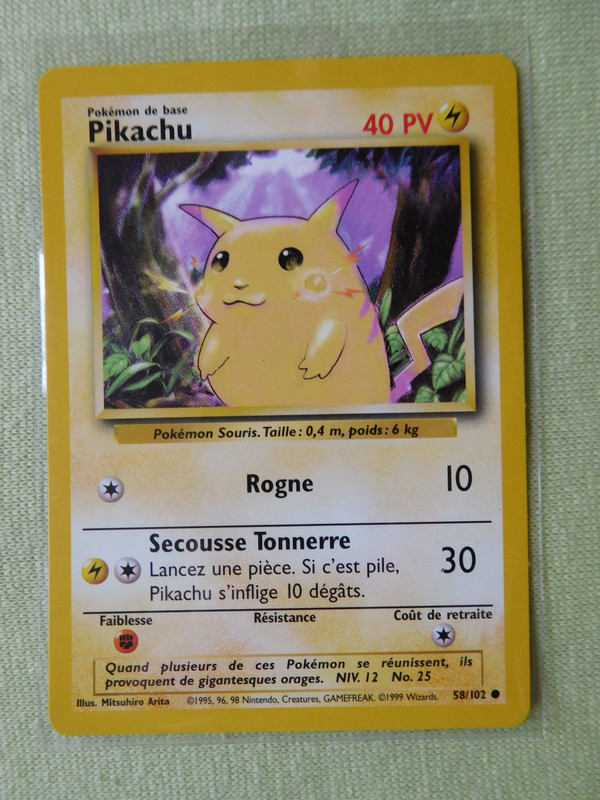
Italian
Italian 1st edition
SPOILER: Click to show
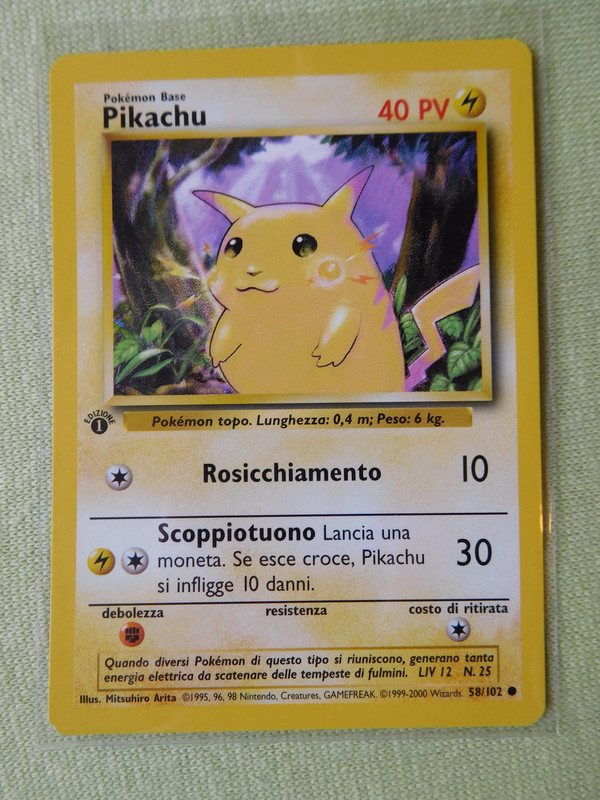
Italian unlimited edition
SPOILER: Click to show
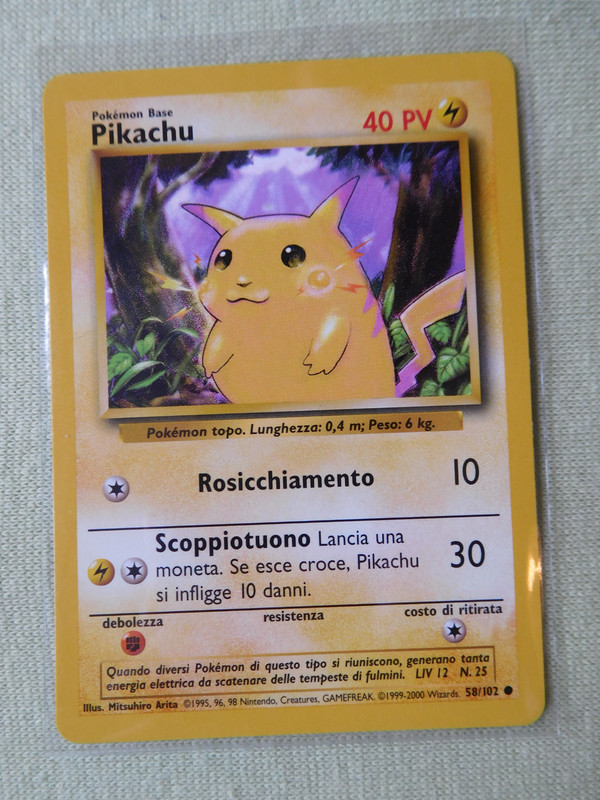
Spanish
Spanish (Latin American) 1st edition ©1999
SPOILER: Click to show
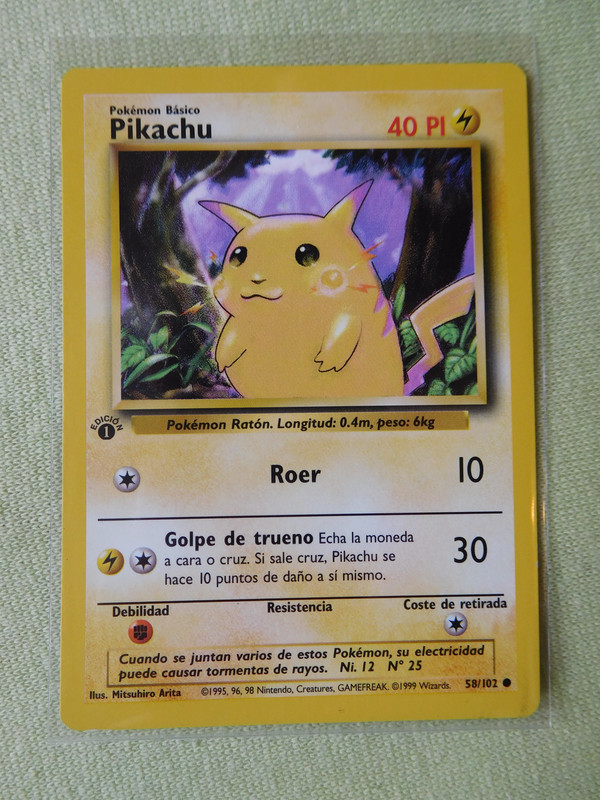
The Spanish 1st and unlimited edition cards were just like the UK ‘4th’ print split into two versions, one with the ©1999 copyright date, and one with the ©1999-2000 copyright date.
The ©1999 cards were for the Latin American Spanish cards, and the ©1999-2000 for the European Spanish cards.
The card pictured above is the 1st edition Latin American Spanish version.
Spanish (European) 1st edition ©1999-2000
SPOILER: Click to show
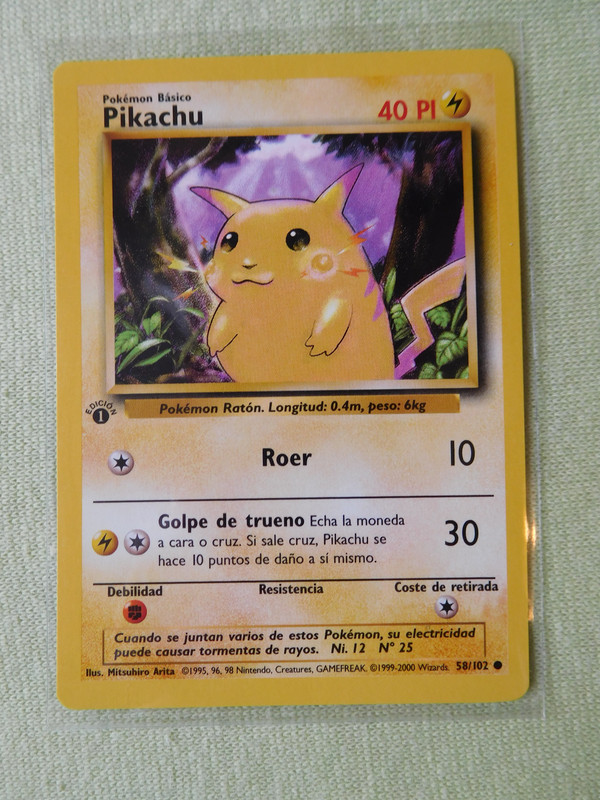
And here we have the 1st edition European Spanish version with the different copyright date.
Spanish (Latin American) unlimited edition ©1999
SPOILER: Click to show
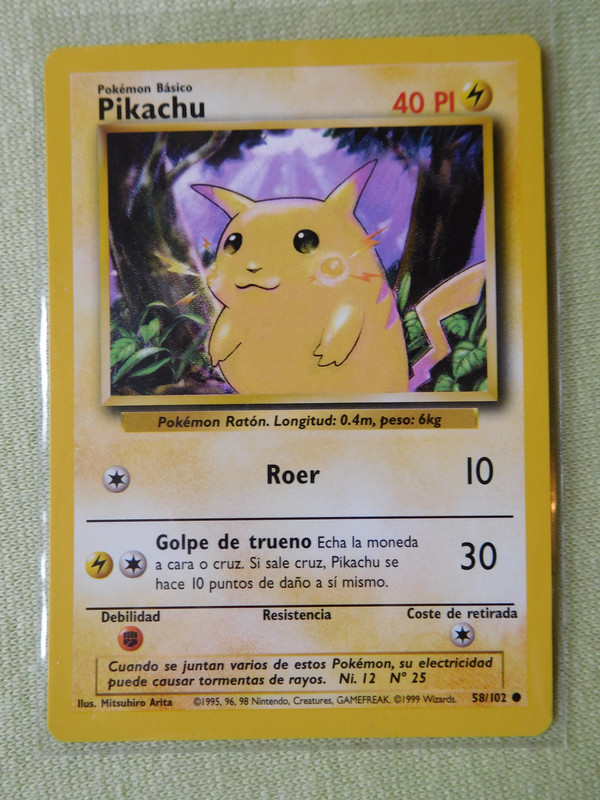
Spanish (European) unlimited edition ©1999-2000
SPOILER: Click to show
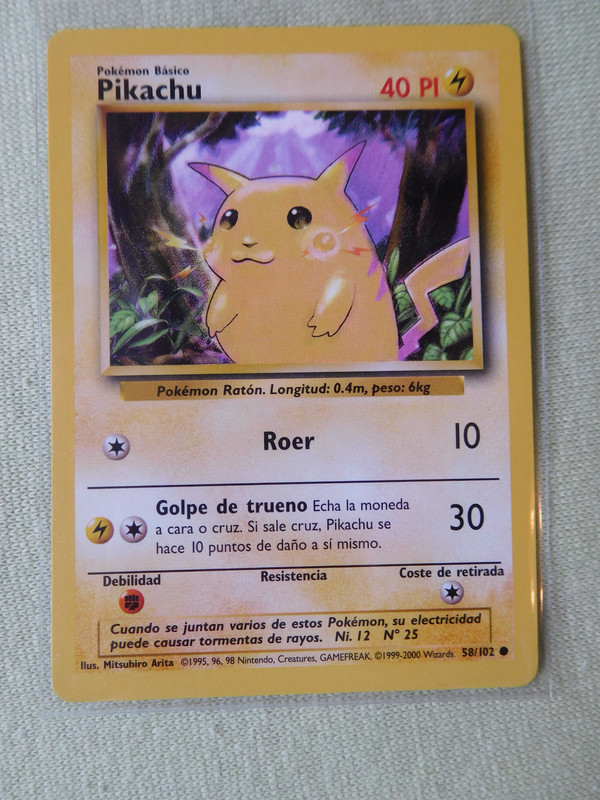
Portuguese
Portuguese 1st edition
SPOILER: Click to show
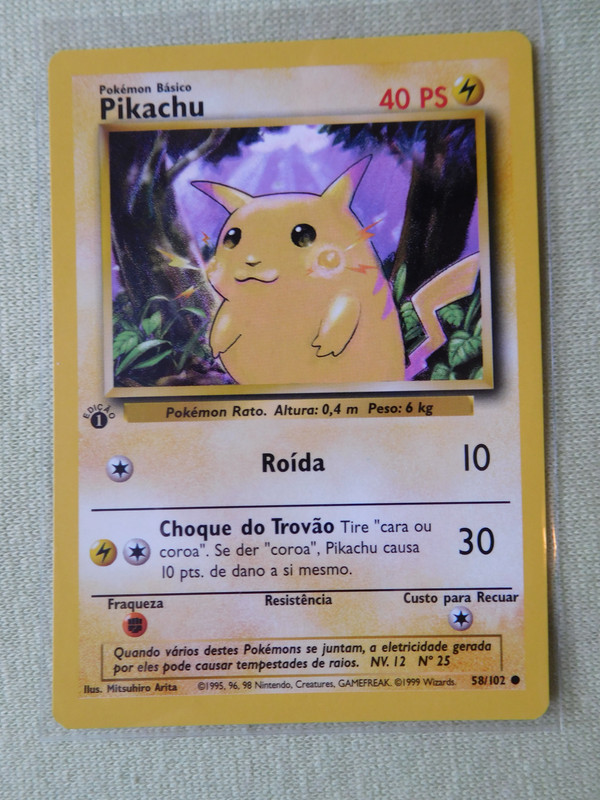
Portuguese unlimited edition
SPOILER: Click to show
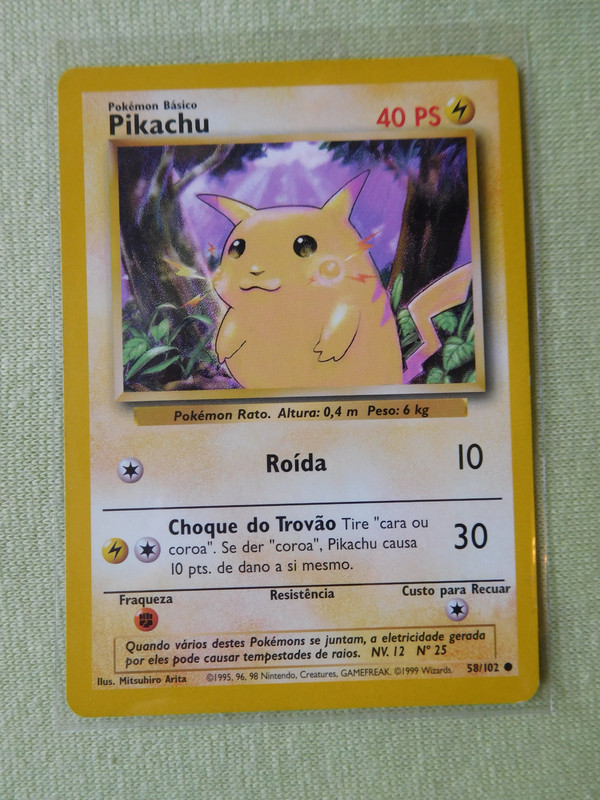
Korean
Korean Pikachu World Collection 2000 set
SPOILER: Click to show
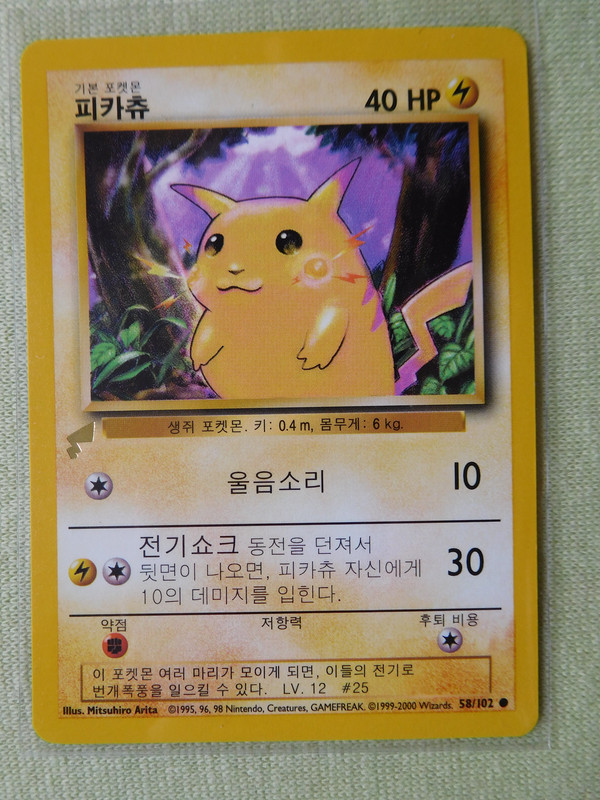
In 2000 the first Pikachu World Collection set was released. This set consists of nine non-Holo Pikachu cards, each with a different artwork and in a different language. All nine of them have a Pikachu Tail stamp at the left, where normally the 1st edition symbol would be.
The nine cards that were featured in this set are:
- English _____'s Pikachu (‘Birthday’ Pikachu - promo nr. 24)
- German Flying Pikachu (promo nr. 25)
- Portuguese ‘Ivy’ Pikachu (promo nr. 1)
- Spanish ‘SNAP’ Pikachu (promo nr. 26)
- Chinese Jungle Pikachu (Jungle set 60/64)
- Dutch ‘WB Kids’ Promo Pikachu (promo nr. 4)
- Italian ‘Bumblebee’ Pikachu (promo nr. 27)
- French Surfing Pikachu (promo nr. 28)
- Korean Base Set Pikachu (Base set 58/102)
Korean 1st edition
SPOILER: Click to show
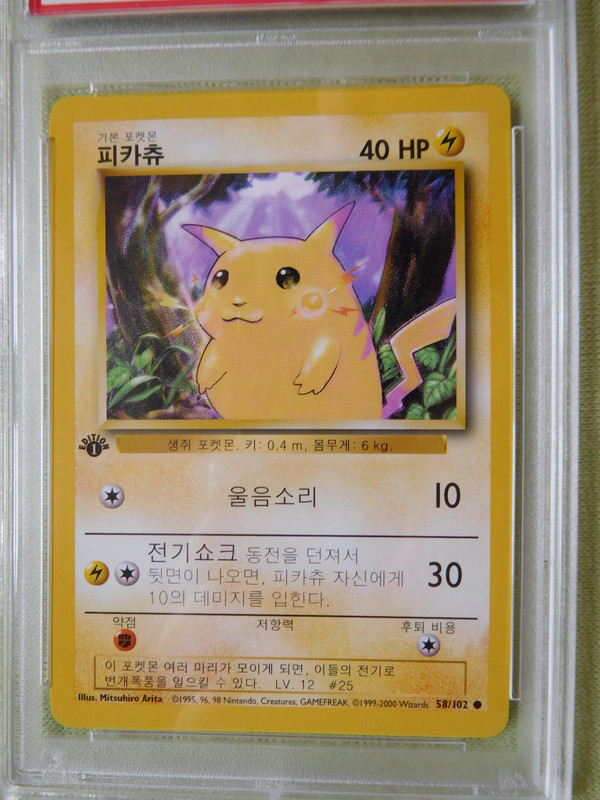
Korean unlimited edition
SPOILER: Click to show
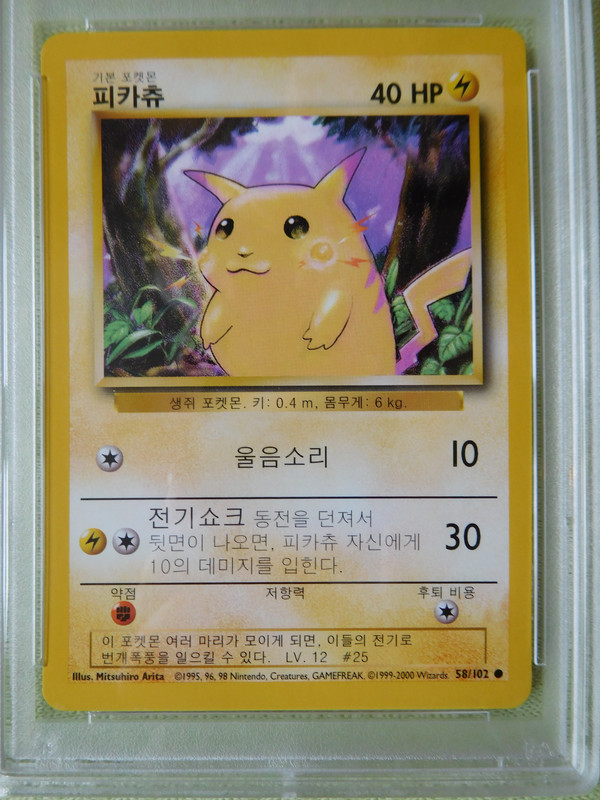
The unlimited edition Korean Cards had a pretty short print run, so these cards are pretty hard to find. Their price-tag is therefore a lot higher than all the other languages mentioned, including the Korean 1st edition Base cards.
Chinese
Chinese 1st edition
SPOILER: Click to show
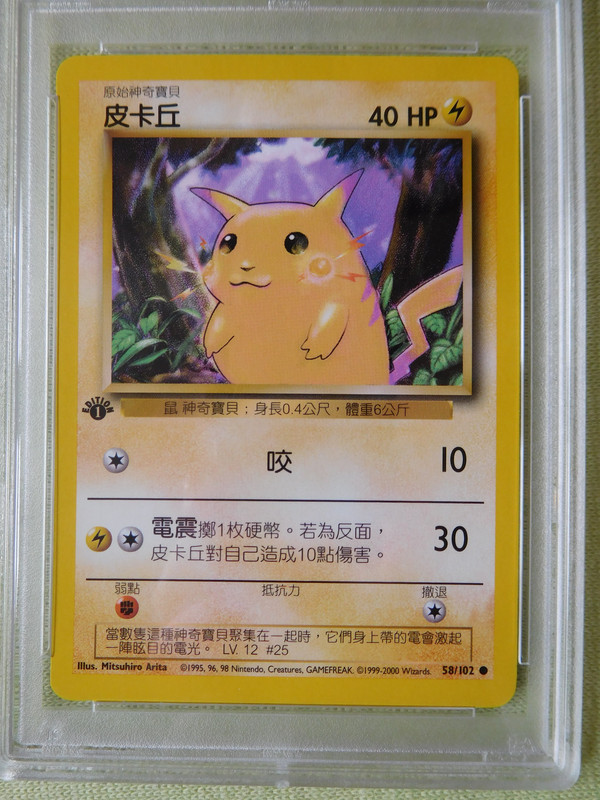
This is one of the only four sets ever printed in Chinese. The others are the EX Legend Maker set, Plusle and Minun Deck, and the POP4 PokéPark promotional set. (And there are also a few loose Chinese cards, like the Pikachu card of the Pikachu World Collection 2000 set mentioned before).
The rumors that there might be both traditional and simplified Chinese Base Set cards aren’t true. This set was only printed in traditional Chinese, as they were never printed in mainland China (where simplified is used). source
Chinese unlimited edition
SPOILER: Click to show
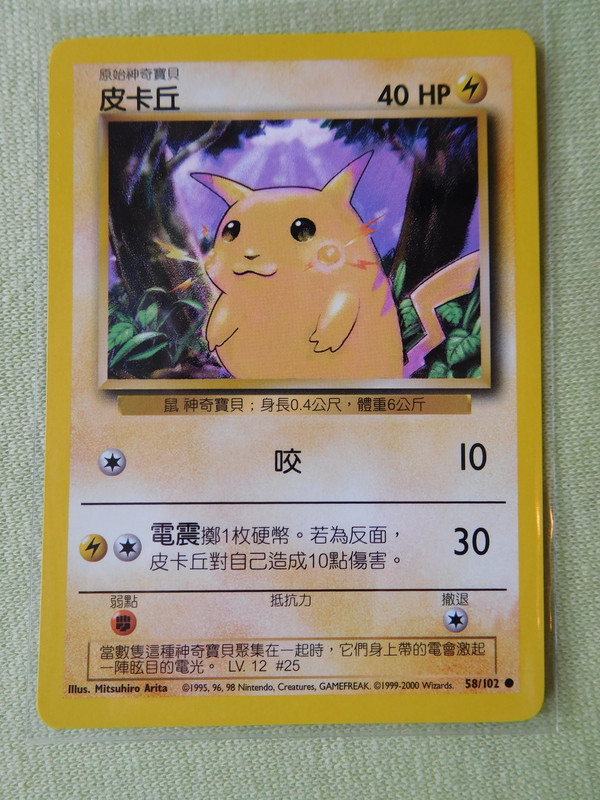
Rare misprints
Although I’ve mentioned a few misprints above, like the Ghost/Phantom 1st edition or Grey stamp, these are misprints that are much less common to find, and some might even be one-of-a-kind occurrences.
Albino misprint
The card itself and the borders of the WotC cards were usually printed separately. Because of this the card border might be misprinted while the card itself is fine. When the yellow of the card is so fine it turned pinkish or whitish, we refer to them as Albino.
Unfortunately, I’m not 100% convinced an actual Albino print error Base Pikachu exists. I’m not even 100% convinced any Albino misprint exist. Yes, I’ve seen a couple of Albino cards in the past, and I even managed to buy one from eBay; which leads me to the following card:
Sun-discolored Albino misprint
SPOILER: Click to show
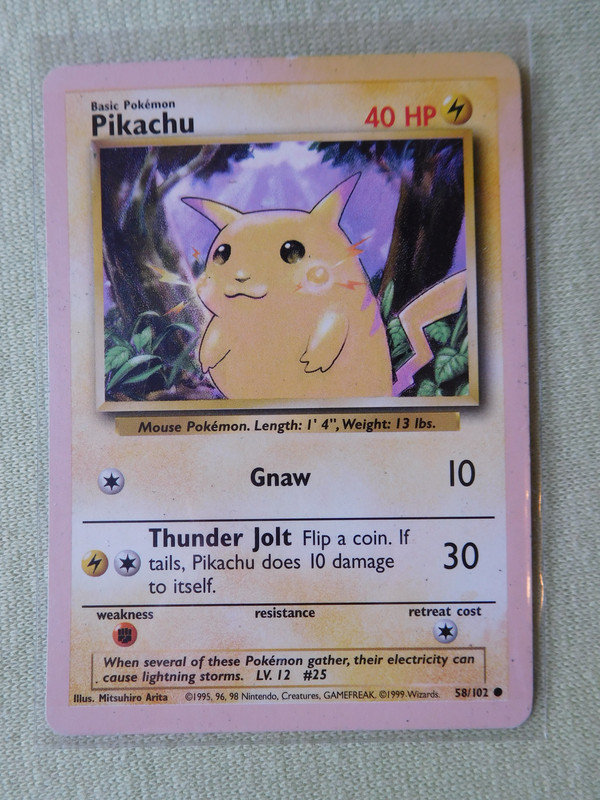
As you can see it has the pinkish border as mentioned. However, there are two things to note:
- At the top right corner of the border it isn’t pinkish, but light yellow instead.
- The entire card is lighter than usual.
This has led me to the conclusion that this card simply has been faded by sunlight by overexposing it for a long period of time. Because of this, and the fact that the scarce few other Albino misprints I’ve seen also had a completely lighter card instead of just the border, I personally think there aren’t any actual Albino printing errors and it’s all just the sun’s doing.
Sun-bleached
SPOILER: Click to show
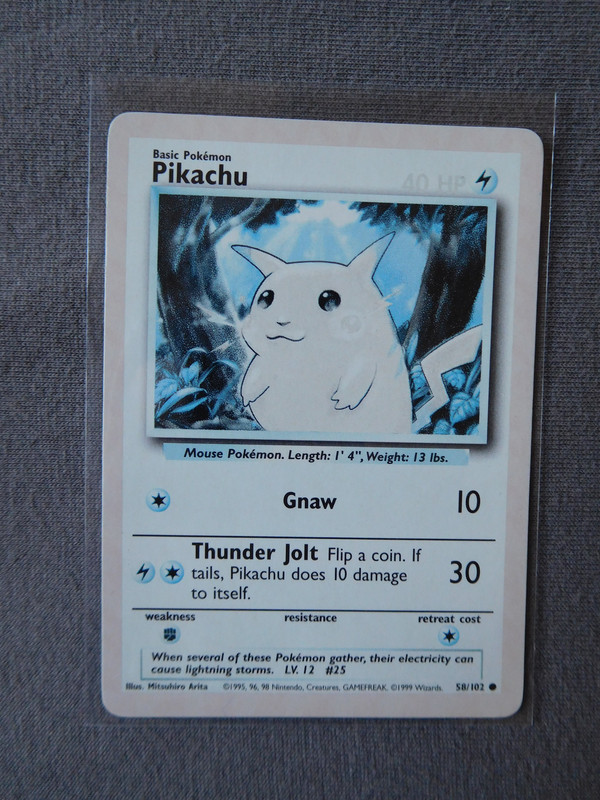
Some people take sun-discoloring to the next level. This card has been discolored by the sun for more than a year. Although it remains a regular Pikachu card, it looks pretty cool competently pale, which is why I’ve bought it for my collection.
And here is another sun-discolored one from the World Collection 2000 set:
SPOILER: Click to show
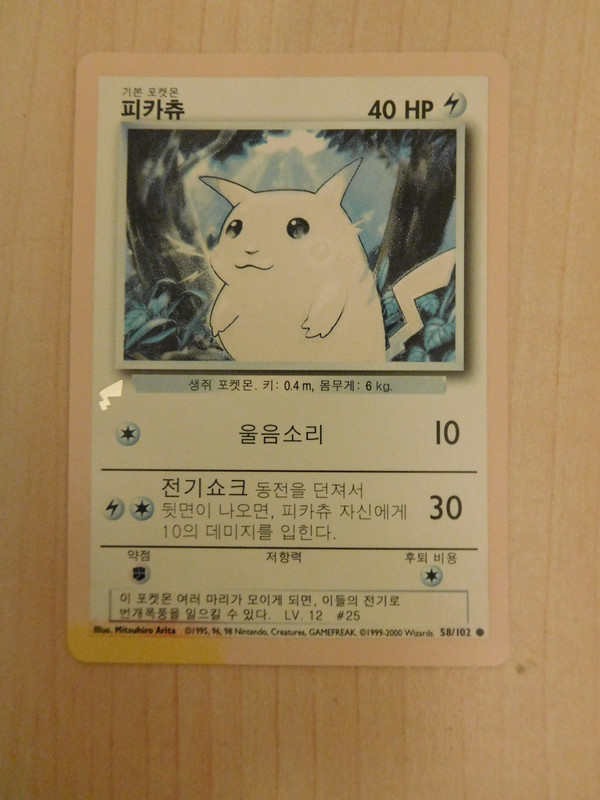
Gold/Orange Border Base Set 2
SPOILER: Click to show
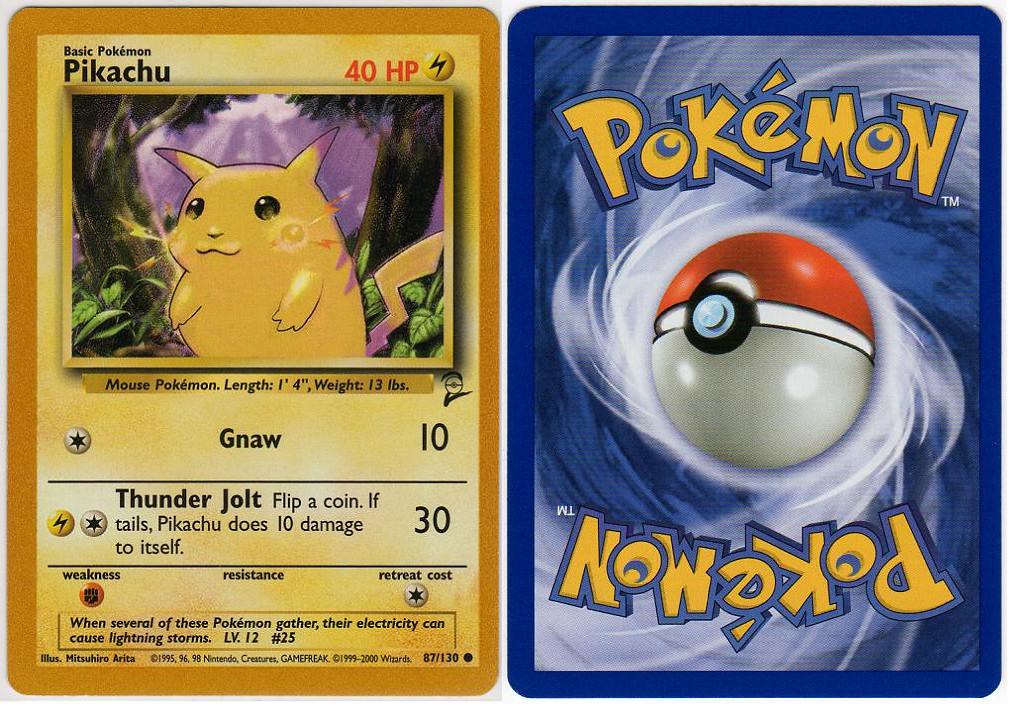
Source: Image from Max’ collection posted on flickr in 2000.
This is one of those cards that is most likely a one-of-a-kind misprint. As you can see in the picture above, the card has a dark orange border, which is most likely a printing defect.
English Thin 1st edition stamp Yellow Cheeks
As mentioned before at the Grey 1st edition stamp entry, the printer is sometimes not printing firmly enough, causing the Grey stamp misprint. The opposite is also true however, where it is printing more firmly causing the Thin 1st edition stamp which became the standard in later WotC releases.
In fact, if you compare the English 1st edition symbols with the 1st edition symbols of all the other languages mentioned above, you will see a small difference. Here are the English 1st edition and Dutch 1st edition symbols (ignore the difference in “edition” and “editie”):
SPOILER: Click to show
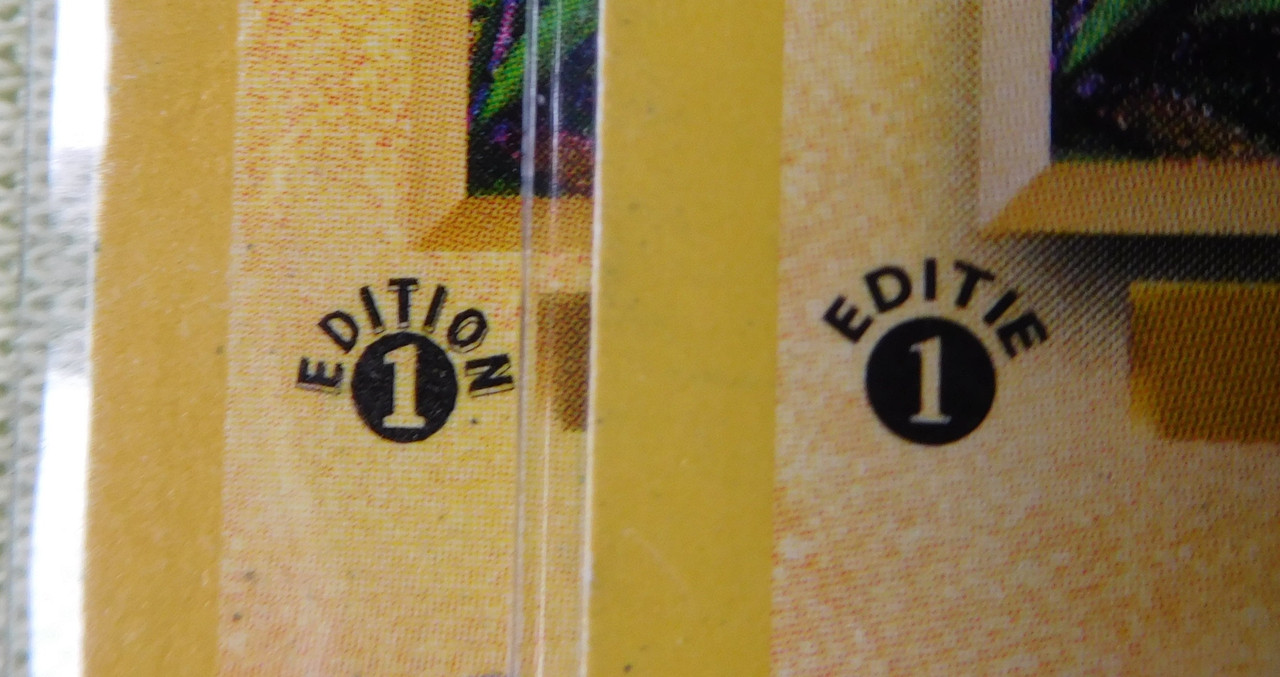
If we look at the “1” in the 1st edition symbol, we can see that the English one (at the back) is wider than the Dutch one (at the front). On very rare occasions, this “Thin” 1st edition printing occurs on English non-holo cards. For Holo Rares it is much easier to find both versions and they aren’t even considered as misprints, but for non-holo cards it is a very rare ‘misprint’. I personally have only seen the English Thin print Base Pikachu twice (one is this Yellow Cheeks thin 3D stamp in the picture below), and I’ve only seen three other Commons/Uncommons with this Thin print difference.
SPOILER: Click to show

Source: From @cinnaminhbun 's collection
These Thin stamp non-Holos aren’t as thin as the Thin Holo Rares, but still thinner than a regular Thick stamp. Here a comparison picture of all three, to see that this Thin stamp Yellow Cheeks Pikachu above is right between the Thin stamp of the Holofoil Rare and Thick stamp:
SPOILER: Click to show


English Thin 1st edition stamp Red Cheeks
SPOILER: Click to show

Source: Part of the collection of @megacon

Source: Part of the collection of @marco .
Here again a comparison picture with an actual Thin stamp Holo Rare:
SPOILER: Click to show

English Grey 1st edition stamp Red Cheeks
A Red Cheeks variant also exists for the Grey 1st edition stamp mentioned above.
E4 member @KingPokemon has one in his collection, and will provide pictures for this article when he has found it.
Square Cut misprint
SPOILER: Click to show
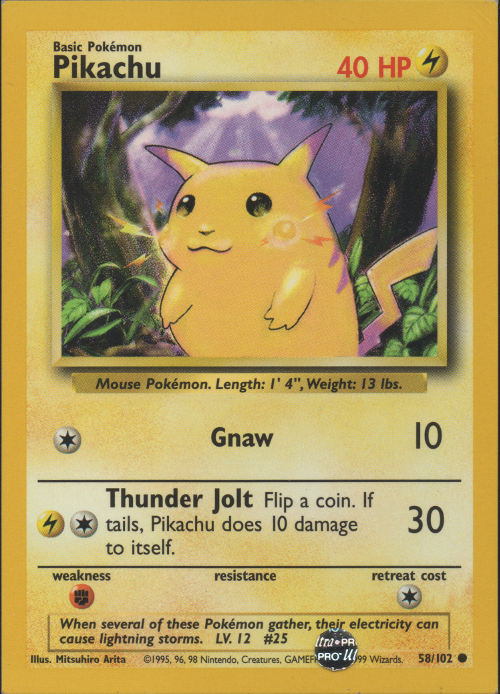
Source: Image from Justin’s collection posted on his website (he’s also active as @justinator here on the E4 Fourum)
SPOILER: Click to show
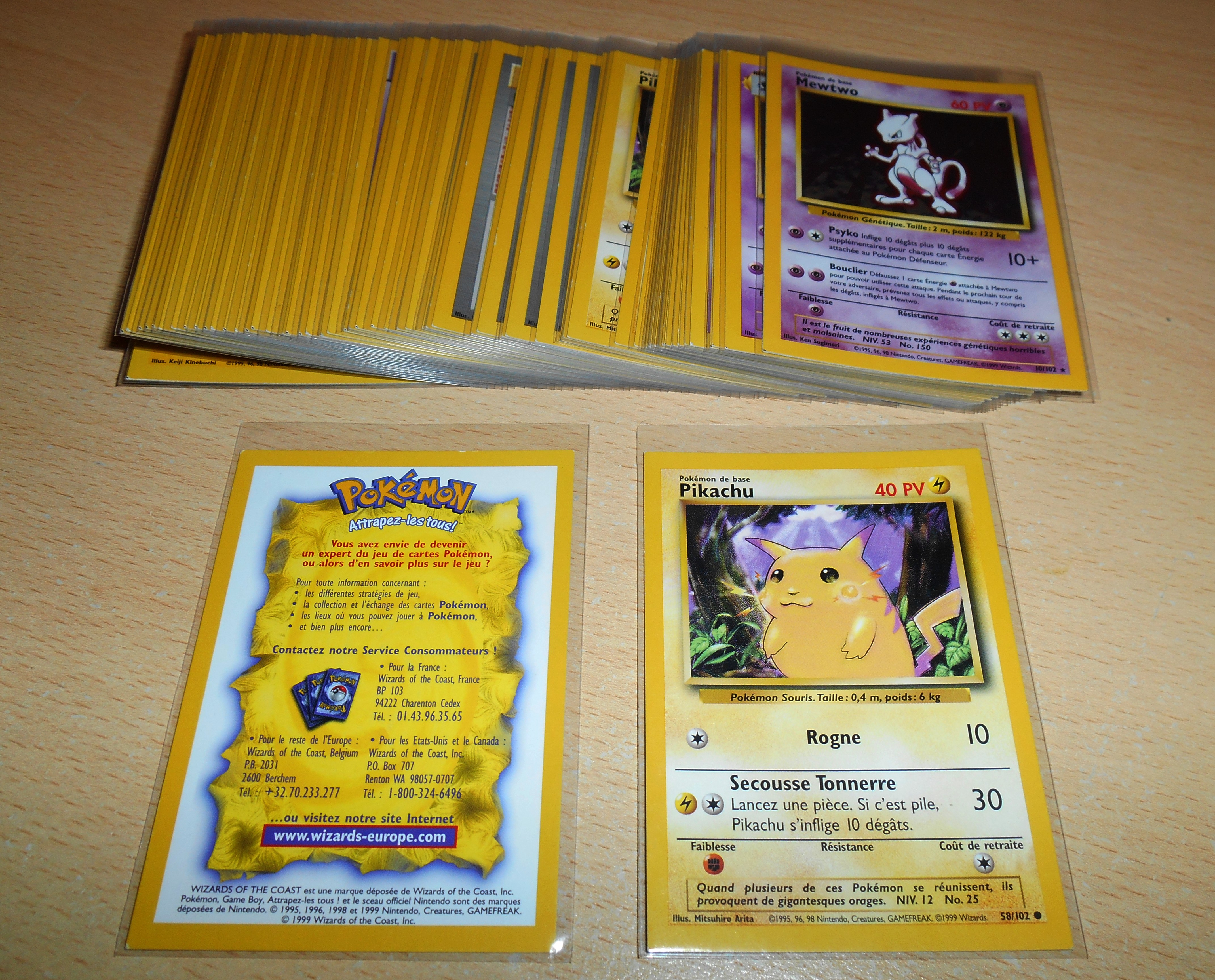
Source: French Square Cut Zap! Deck from the collection of @linkdu83 .
Square Cut misprints aren’t extremely uncommon, but they are when you try to find them on a particular card. I personally have seen three Square Cut Base Pikachu Cards (including the two above) so far.
Other cut/printing/ink misprints
We’ve probably all seen them: cards that are slightly or completely miscut; crimped at either the top or bottom due to incorrect pack sealing; cards with Squared corners like the Square Cut mentioned above; or cards with ink drops or ink completely wiped out over parts of the card.
I don’t think anyone considers these as different versions of a card, but it’s still worth the mentioning for the die-hard collectors like myself.
Mitsuhiro Arita autographed
Mitsuhiro Arita has three different autographs when he signs cards: one of them is his English signature, which is probably the most well-known; one is his Japanese signature; and one is his English plus an additional text describing the Pokémon of the card. This text describing the Pokémon usually states “I Choose You!” when the card is a Pikachu, but I’ve also seen the texts “Fat Pikachu” or “Pika Pika”.
Mitsuhiro Arita’s English autograph
SPOILER: Click to show
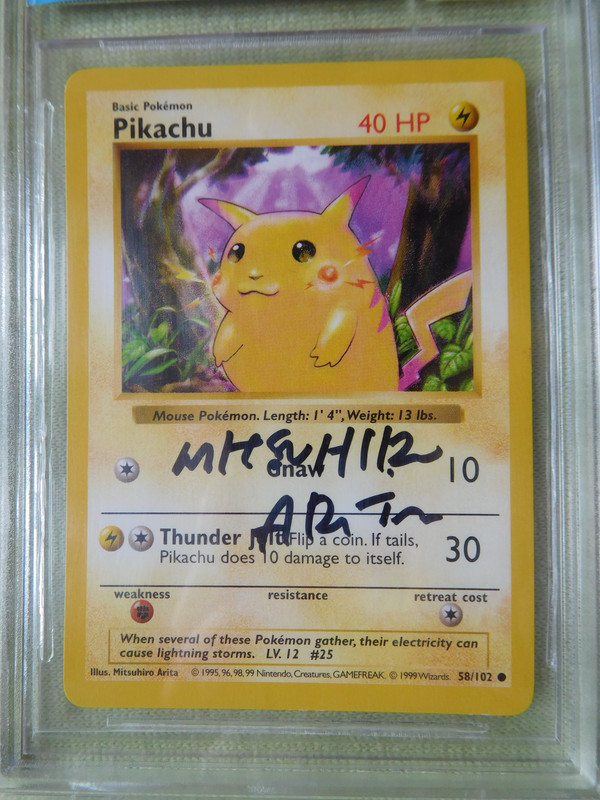
Mitsuhiro Arita’s Japanese autograph
SPOILER: Click to show
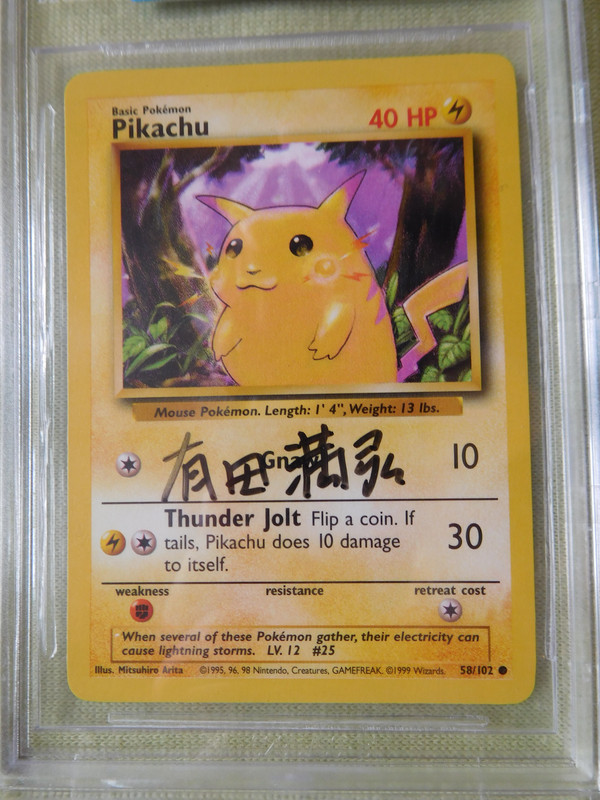
CP6 / XY Evolutions
IN 2016, the CP6 set has been released as 1st edition in Japanese which consists of artworks from the original Base Set. This set also featured the Base Pikachu artwork. This set has been released as CP6 in Japanse 1st edition and Korean, and as XY Evolutions in English, German, French, Italian and Spanish (and the Russian and Portuguese releases are cancelled for this set). This means seventeen more cards have been added to the list (the Japanese 1st edition and Korean; five Theme Deck special release; five Reverse Holos; and five regular non-Holos). (Apparently they’ve simply reprinted the Japanese cards with 1st edition symbol, because they were too lazy to remove the 1st edition symbol. So I doubt the unlimited edition Japanese CP6 set will be released. So the unlimited edition Japanese CP6 has never been released.)
Another interesting thing to note, is that the Pikachus in the artwork of the CP6 / XY Evolutions cards are slightly lower than on the original Base set artwork.
Japanese
Japanese CP6 1st edition
SPOILER: Click to show
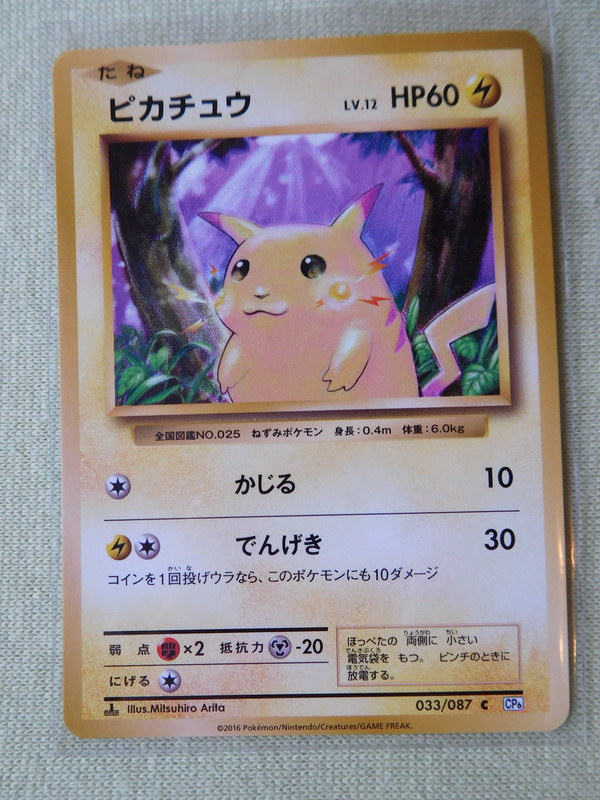
Korean
Korean CP6
SPOILER: Click to show
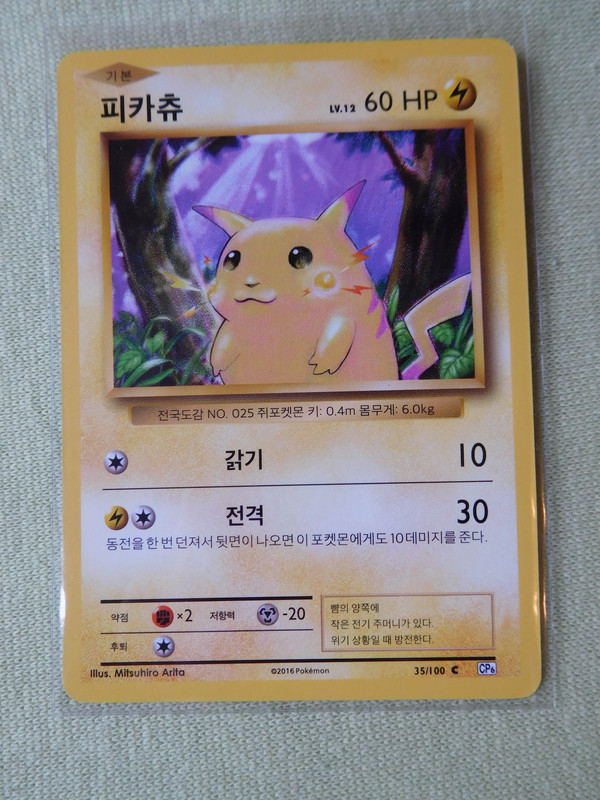
English
English XY Evolutions Theme Deck (Shattered Foil)
SPOILER: Click to show
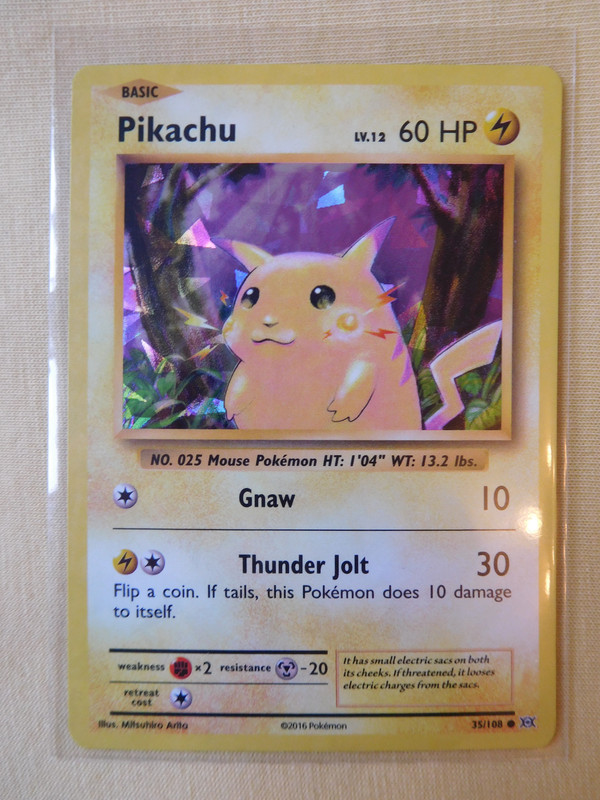
For the XY Evolutions set there are also two Theme Deck releases, one with the Pikachu you see right here, and one with Mewtwo. Both have a Shattered Glass kind of holofoil pattern. The Theme Deck Shattered Holofoil, Reverse Holo and non-Holo Pikachus combined make for a total of fifteen additional Base Artwork Pikachus with the release of XY Evolutions.
English XY Evolutions Reverse Holo
SPOILER: Click to show
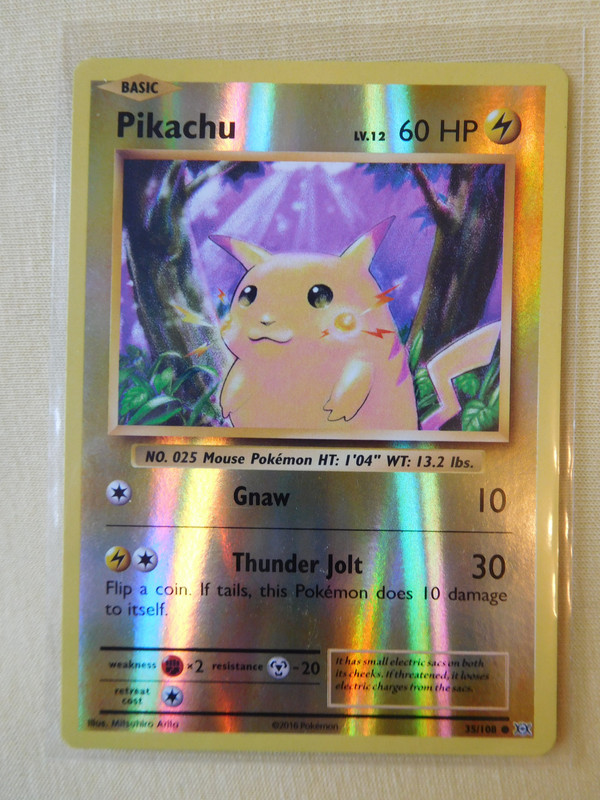
English XY Evolutions non-holo
SPOILER: Click to show
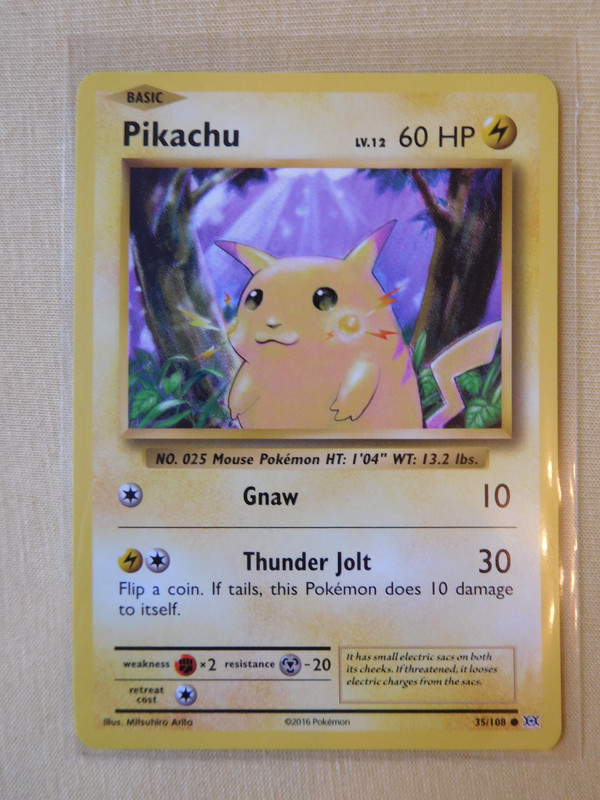
German
German XY Evolutions Theme Deck (Shattered Foil)
SPOILER: Click to show
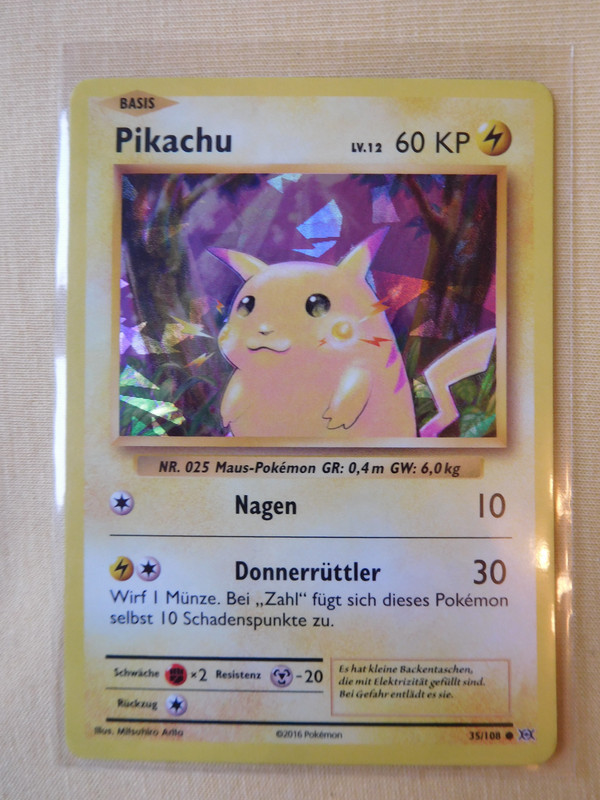
German XY Evolutions Reverse Holo
SPOILER: Click to show
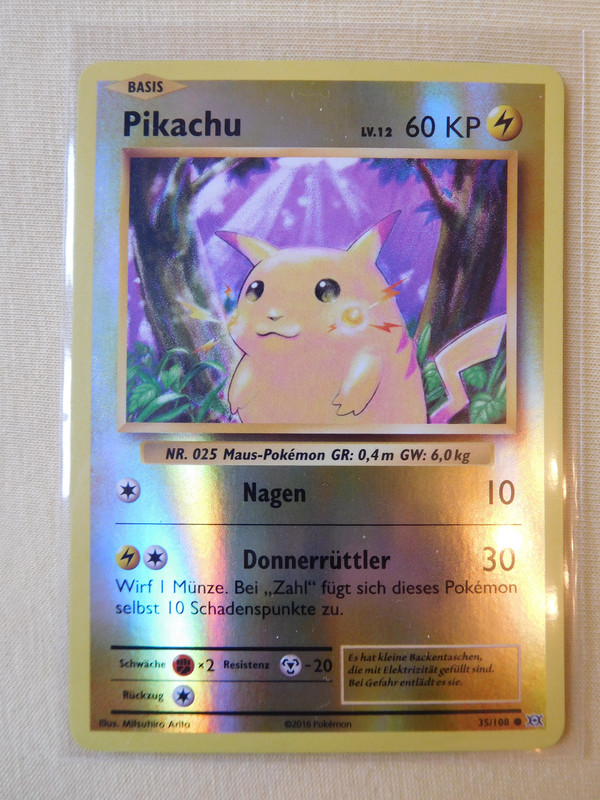
German XY Evolutions non-holo
SPOILER: Click to show
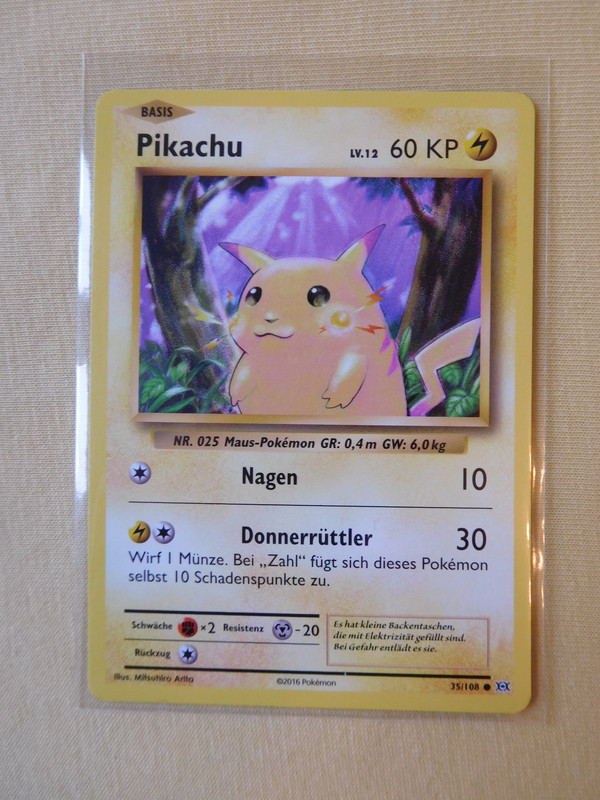
French
French XY Evolutions Theme Deck (Shattered Foil)
SPOILER: Click to show
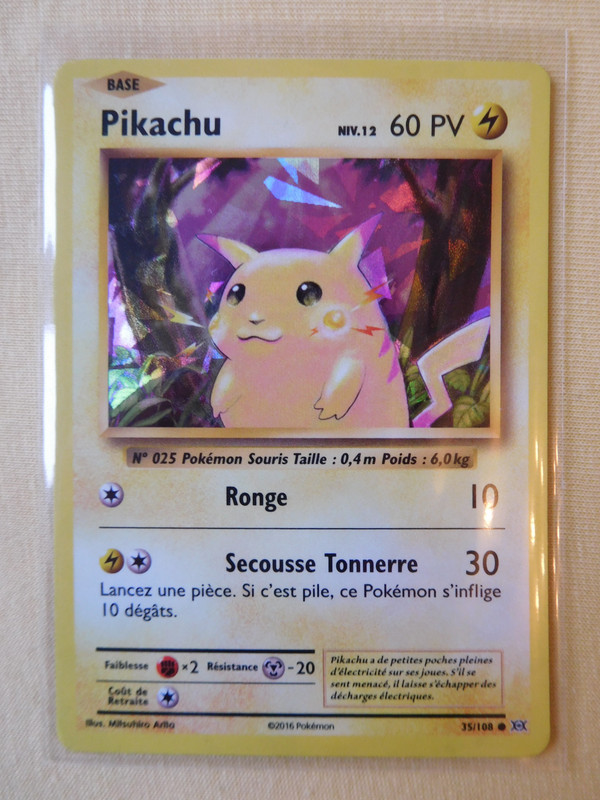
French XY Evolutions Reverse Holo
SPOILER: Click to show
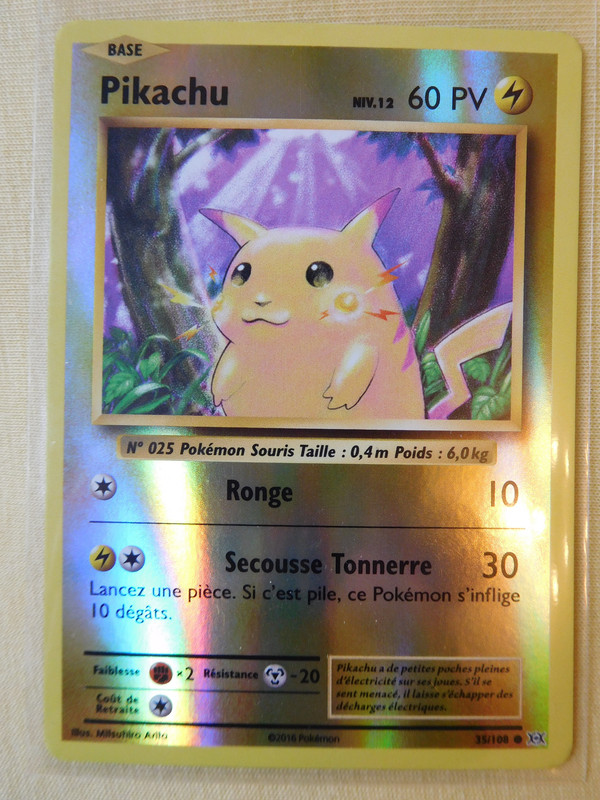
French XY Evolutions non-holo
SPOILER: Click to show
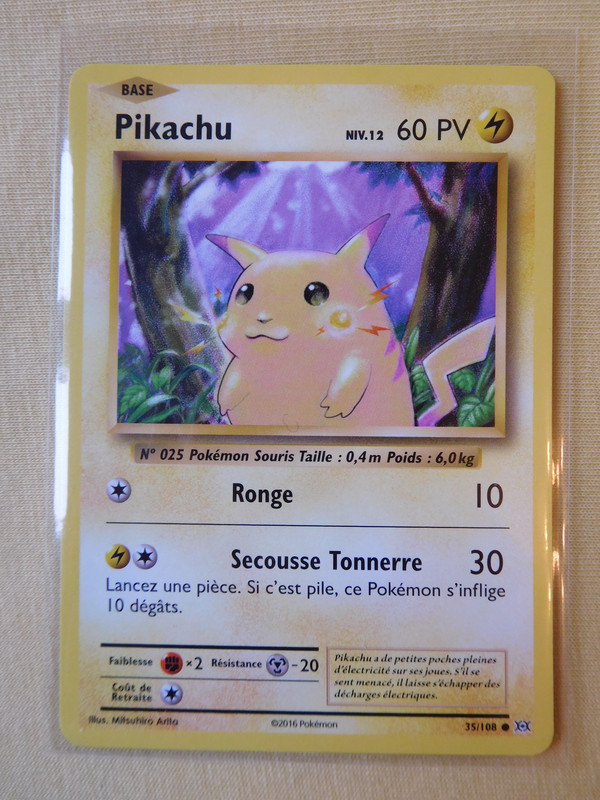
Italian
Italian XY Evolutions Theme Deck (Shattered Foil)
SPOILER: Click to show
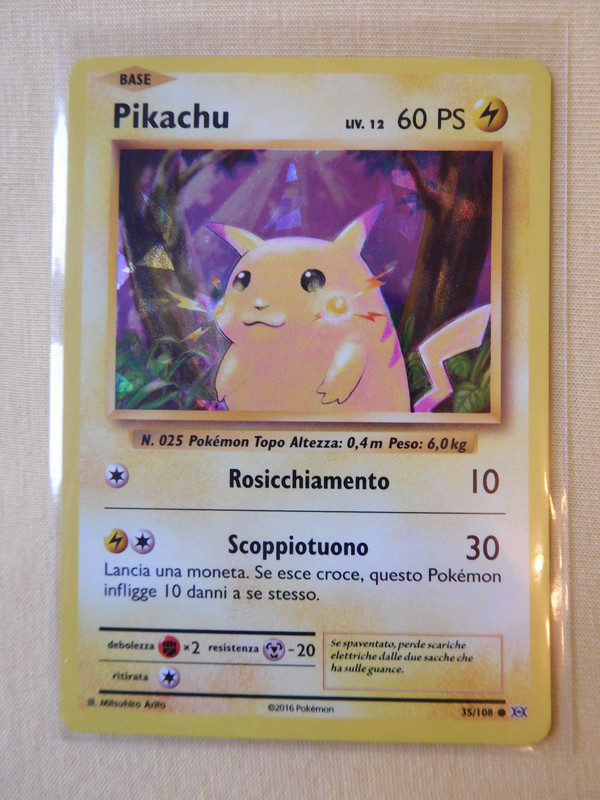
Italian XY Evolutions Reverse Holo
SPOILER: Click to show

Italian XY Evolutions
SPOILER: Click to show

Spanish
Spanish XY Evolutions Theme Deck (Shattered Foil)
SPOILER: Click to show

Spanish XY Evolutions Reverse Holo
SPOILER: Click to show

Spanish XY Evolutions
SPOILER: Click to show

XY Evolutions Misprints
For the English XY Evolutions release there have been some ink misprints floating around.
English XY Evolutions Blue Color Misprint
This one with a blue/dark purple background instead of regular purple. I’ve seen three different cards with this blue background, so it might be more common than I anticipated, instead of a one-of-a-kind flaw. The picture below is the one I bought:
SPOILER: Click to show

English XY Evolutions Maroon Color Misprint
The red/maroon miscolored background might be rarer, since I’ve only seen two times thus far, of which I bought one from @fritz of this forum:
SPOILER: Click to show



And as you can see at the top two purple background Pikachus in the second picture above, there are also color differences among the purple backgrounds themselves, where I have both a light and darker purple background Pikachu from XY Evolutions.
English XY Evolutions Reverse Holo Light Blue Color Misprint
There is also a fifth color variation misprint that only occurred on Reverse Holo variants, which is a very light purple:
SPOILER: Click to show

XY Evolutions autographed by Mitsuhiro Arita
Just like the Base Set Pikachu, the XY Evolutions Pikachu also has some autographed cards. Mitsuhiro Arita was the guest of honor at the Milan Cartoomics on March 3-5, 2017 in Italy. People at the event could have their cards get autographed by Mitsuhiro Arita, and for those who couldn’t be present at the event a mail-service was set up.
I’ve send in the following eight cards myself:
SPOILER: Click to show

The non-holo XY Evolutions Pikachu in all seven available languages (English, Japanese, German, French, Italian, Spanish and Korean), and as eighth card an English Theme Deck holo. All cards are autographed with his Japanese signature.
Bigger & Smaller & non-Cardboard
Jumbo
SPOILER: Click to show

One more card worth mentioning is the Jumbo-sized variant of the Base Set Pikachu, which is similar to the UK ‘4th’ print (with ©1999-2000) mentioned in this article.
This Jumbo Card measures 145.5 by 206.5 mm (a regular sized Pokémon Card can be seen at the bottom right of the picture). This card was released with the Top Deck Magazine in February of 2000.
Autographed Jumbo
SPOILER: Click to show

Just like the regular sized Pikachus, there are also autographed Jumbo cards. This card above that I currently have in my collection contains the following signatures:
SPOILER: Click to show
I don’t think he needs introduction, but just in case relatively new collectors read this: Mitsuhiro Arita is a famous Japanese Pokémon illustrator. He’s been an active illustrator for the Pokémon TCG since the beginning. The Base Pikachu is one of his illustrations, but the recent Mewtwo GX 78/73 Secret Rare from SM Shining Legends (Mewtwo in the laboratory tube) is also his illustration for example. He signs either with his English or Japanese signature, or in this case above both. (Mitsuhiro Arita autographed cards are probably one of the easiest to find, since he signs a lot of them at Pokémon events, although they are still very popular.)

The PCL stands for Pokémon Card Laboratory. PCL employees are basically the creators of the Pokémon TCG in Japan, and they handle the R&D (Research & Development) of the Pokémon TCG. They are also in charge of designing new cards, and have authority on any matter related to the Pokémon TCG.
Source:
Yukinori Torii was showing some e-reader’s he created at one of the events. He worked in many Pokémon related games, and searching for his name on Bulbapedia results in multiple search results.

BDS is Richard Walkoski, a top level Pokémon TCG tournament organizer and judge, better known as Big Daddy Snorlax.
Source:

DMTM is Mike Boozer, better known as Dark Master Trainer Mike. He was a WotC representative and was present at Pokémon events in the early WotC days. He’s also pretty well-known for spreading the rumors and pictures of the Prerelease Raichu.
Source:

MTM is the signature of Mike Gills (the manager of organized play).

The last signature is from (Dark Master) Steven Kam. He was the manager of the marketing dept for WOTC and attended lots of Pokemon events back in the day.

Source for the last two signature of Mike Gillis and Steven Kam can be found here on the E4 forum thanks to @jkanly .
Sun-discolored Albino misprint Jumbo
SPOILER: Click to show

Just like the regular sized Pokémon TCG cards, the Jumbo cards can get sun-discolored as well. The card above is a partially Albino Jumbo Pikachu.
Solid Gold
SPOILER: Click to show

Between October 19th and November 7th, 2016 a Solid Gold Pikachu was available for sale in Japan for a whopping 200,000 Japanese Yen (~2,000 USD) excluding taxes/shipping. This card has been released for the Pokémon 20th anniversary. The card weights 11 gram (which would be ~335 USD for 18 karat and ~445 USD for 24 karat in the current gold economy). It was only available on the Japanese Pokémon Center website or the 7net webshop, and was shipped out on December 22nd, 2016. How many copies have been made is unknown, but considering the price I doubt there are a lot out there.
source1 source2
Japanese 10th Anniversary Miniature Phone Charm Promo
SPOILER: Click to show

This hard plastic miniature card is exactly the same as a Japanese Base Pikachu (with Rarity symbol). The only difference: it’s just 27.0 by 19.5 mm. This official card was released together with a Japanese 1st edition EX FireRed & LeafGreen Charizard EX miniature as part of the 10th Anniversary of the Pokémon TCG:
SPOILER: Click to show

French Jumbo Base Pikachu from a Belgium tournament
SPOILER: Click to show
 Source: collection of @linkdu83
Source: collection of @linkdu83
Although it looks kinda fake, this French Jumbo Base Pikachu was given at a Belgium tournament back in the day. This card is in possession of @linkdu83 , who might have some better pictures and more information about these?
There was also another Jumbo card from that same tournament which is similar as the French insert used with some WotC era promos (i.e. the Legendary Birds for example).
Japanese Teach Set 2000 Pikachu
In 2000 a Teach Set was created to help new Japanese players learn the Pokémon TCG. This set contained a total of 10 cards, and one of them had the Base Pikachu artwork:
SPOILER: Click to show


The size of these cards are 86.5 by 142.5 mm. A regular sized and Jumbo sized TCG card would be 63.0 by 87.0 and 145.5 by 205.5 mm respectively. More information about this and the other Teach Sets can be found in my Teach Set article.
Super Jumbo Base Set 2 Pikachu
In the back of the following picture you can see a Base Pikachu (most likely Base Set 2):
SPOILER: Click to show
I don’t know the measurements yet (will update as soon as I do), but it seems to be at least 500 mm high.
So far seven of these Super Jumbo Cards have popped up (and Pikachu wasn’t one of them): Fire Energy; Grass Energy; Charmander; Nidoran; Switch; Potion; Doduo. These seven are in possession of The Charizard Authority / TCA Gaming (@TCAGaming ). He briefly shows the Fire Energy and Charmander in this video.
Super Jumbo Italian 1st edition Base Set Pikachu
SPOILER: Click to show

I was able to buy one of the Super Jumbos myself. They aren’t the English Base Set 2 mentioned above however, but Italian 1st edition Base Set instead. I’ve bought the Pikachu, as well as an additional Lightning Energy, which you can see in the picture above. The measurements are: height: 561 mm; width: 399 mm; thickness: 2mm. In the picture above you can see my house shoe below it (shoe size: 43/44 in EU; 9 in AUS/UK; 10 in US). Here an additional picture with a size comparison to a the earlier mentioned Jumbo, Teach Set, regular TCG-sized, and Miniature Phone Charm Pikachus:
SPOILER: Click to show

The seller also had a few other one available: 2 Charmeleons; 4 Charmanders; 1 Doduo; 4 Machop; 4 Male Nidoran; 2 Potions; 6 Fighting Energies; 4 Fire Energies; 2 Grass Energies; 1 additional Lightning Energy.
Ultra Jumbo Base Shadowless unlimited edition Yellow Cheeks Pikachu
SPOILER: Click to show

In the ‘Pokémon Bible’ (page 345), this picture can be found. It seems to be approximately 2 meters high. And it’s an enlarged version of the Shadowless unlimited edition Yellow Cheeks variant. No idea if it still exists or if it was destroyed shortly after this event.
Outro / Word of author
So there you have it. All card variants of the Base artwork Pikachu. A lot more than most people would think, and more variants are still being discovered or released.
If you happen to have any cards not mentioned, please let me know (and I will add them to the list after I bought them from you ![]() ). If you have pictures of any cards not mentioned, but you don’t own them yourself, also please let me know. I’m always interested to see/hear about other Base artwork Pikachu variants.
). If you have pictures of any cards not mentioned, but you don’t own them yourself, also please let me know. I’m always interested to see/hear about other Base artwork Pikachu variants.
Thank you for reading, and make sure to leave any feedback in the comments down below.
Greetz,
Quuador (Kevin)
PS: As you may have been able to tell by all the information provided, I love the Base Pikachu for all its variations and being the first Pikachu created (well, second actually, two promo cards were released before the Japanese No Rarity Base set and one of those two was a Pikachu…) Anyway, because I like all these variations for the Base Pikachu, I even started collecting the Base Pikachu from all extended artwork artists I could find. Here you can see all the ones I have thus far (49), and more are incoming every time. Close-ups of all of these can also be found on my Instagram.

